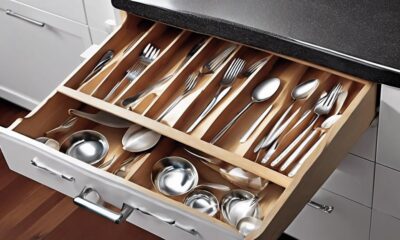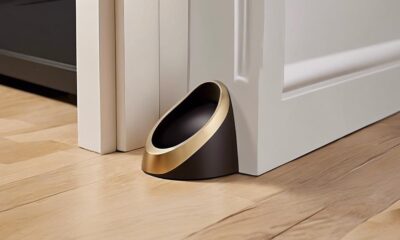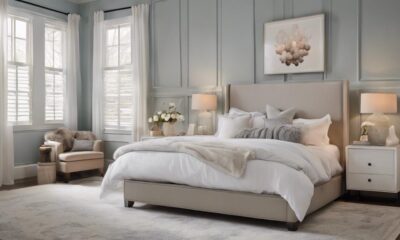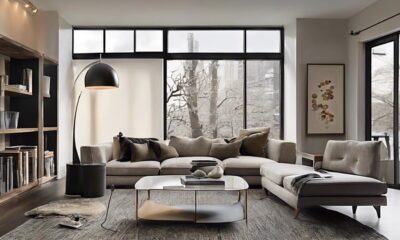Appliances
Ceiling Fan Safety: Will It Fall On You?
2025

In this article, we delve into the intriguing question of what the odds are of a ceiling fan unexpectedly plummeting onto us.
As homeowners, it’s only natural to be concerned about the safety and stability of our ceiling fans. With a blend of practicality and professionalism, we explore the various factors that can impact the security of these fixtures.
By examining installation guidelines, common causes of failures, and the importance of regular maintenance, we aim to provide you with a comprehensive understanding of ceiling fan safety.
Furthermore, we analyze the effects of speed, vibration, and room conditions on their stability.
So, let’s embark on this informative journey, ensuring that we have all the knowledge needed to keep our ceiling fans secure and our peace of mind intact.
Key Takeaways
- Proper installation and regular maintenance are crucial for ensuring the safety of ceiling fans.
- Factors such as secure attachment, correct electrical connections, and choosing the right fan size and type contribute to ceiling fan stability.
- Guidelines for secure installation include choosing a sturdy support structure, using a mounting kit, and following manufacturer’s instructions.
- Additional factors affecting ceiling fan safety include vibration analysis, fan design optimization, room temperature, and the durability of fan blade material.
Understanding Ceiling Fan Safety
Understanding ceiling fan safety is crucial for ensuring the well-being of individuals and minimizing the risk of accidents. When it comes to ceiling fan installation, there are several important tips to keep in mind.
First and foremost, it’s essential to follow the manufacturer’s instructions carefully. This includes properly securing the fan to the ceiling using the appropriate hardware and ensuring that the electrical connections are done correctly.
Additionally, it’s important to choose the right size and type of ceiling fan for the room. Installing a fan that’s too large or too small can result in inadequate air circulation or excessive strain on the electrical system, leading to potential accidents.
In order to prevent common ceiling fan accidents, regular maintenance is key. It’s recommended to inspect the fan blades periodically, looking for any signs of damage or wear. Loose or wobbly blades should be tightened or replaced immediately to avoid potential hazards.
Furthermore, keeping the fan clean and free of dust and debris is crucial for optimal performance and safety.
Factors That Affect Ceiling Fan Stability
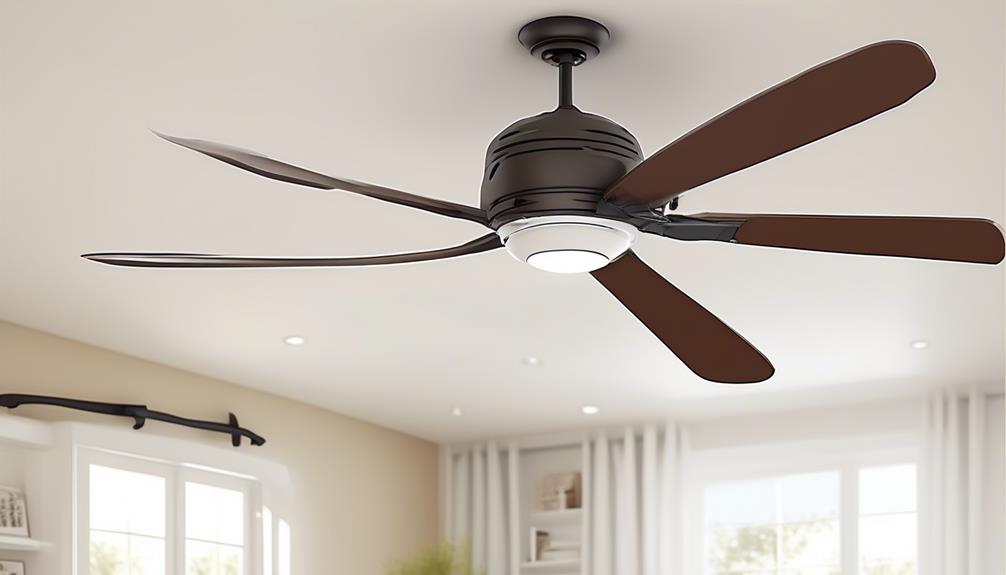
When it comes to ceiling fan stability, there are two key factors that we need to consider: installation and mounting, and fan quality and maintenance.
Proper installation and mounting are crucial in ensuring that the fan is securely attached to the ceiling. This involves following the manufacturer’s instructions and using appropriate hardware to secure the fan in place. It is important to ensure that the ceiling is strong enough to support the weight of the fan and that the electrical connections are properly done.
Additionally, the quality of the fan itself, as well as regular maintenance, play a role in its stability. High-quality fans are designed to be more stable and less prone to wobbling. Regular maintenance, such as cleaning the blades and checking for any loose screws or parts, can help prevent stability issues.
Installation and Mounting
To ensure ceiling fan stability, proper installation and mounting techniques must be followed in a precise and technical manner. The process of installing and mounting a ceiling fan may seem straightforward, but it requires careful attention to detail. A secure mounting is crucial to prevent the fan from falling and causing potential harm. Here is a table outlining the key factors that affect the stability of a ceiling fan:
| Factors | Description | Importance |
|---|---|---|
| Mounting Bracket | Ensures the fan is securely attached | Critical |
| Ceiling Support | Determines the weight the ceiling can bear | Essential |
| Electrical Connections | Ensures proper wiring for safe operation | Vital |
Fan Quality and Maintenance
Fan quality and maintenance play a crucial role in ensuring the stability of a ceiling fan. Proper fan maintenance is essential for maintaining the fan’s stability and preventing any potential hazards.
Regular cleaning of the fan blades and motor is necessary to prevent the accumulation of dust and debris, which can affect the fan’s performance.
Additionally, checking and tightening all screws and connections regularly is important to ensure that the fan remains securely attached to the ceiling.
Fan durability is also a key factor in maintaining stability. Investing in a high-quality fan made from durable materials can help prevent any structural issues that may arise over time.
Regular inspections and servicing by a professional can further enhance the longevity and stability of the fan.
Installation Guidelines for Secure Ceiling Fans
When it comes to installing ceiling fans securely, there are two important factors to consider: proper mounting techniques and secure attachment methods.
These guidelines ensure that the fan is securely fastened to the ceiling, reducing the risk of accidents and ensuring optimal performance.
Proper Mounting Techniques
For optimal security and stability, it’s essential to adhere to proper mounting techniques when installing a ceiling fan.
Proper installation starts with selecting the right location on the ceiling. It’s crucial to choose a sturdy support structure, such as a ceiling joist, to ensure the fan’s weight is evenly distributed.
Before attaching the fan, it’s important to secure the mounting bracket properly. The securing bracket should be affixed to the ceiling joist using appropriate screws or bolts, ensuring that it’s tightly fastened.
Additionally, it’s recommended to use a ceiling fan mounting kit, which typically includes a support brace that provides extra stability. This ensures that the fan is securely anchored to the ceiling and prevents any potential wobbling or damage over time. Adhering to proper ceiling fan support requirements is crucial, especially for fans installed on older or less stable ceilings. Always follow the manufacturer’s guidelines to ensure both safety and optimal performance of your ceiling fan.
Following the manufacturer’s instructions precisely and using the necessary tools will contribute to a secure and stable ceiling fan installation.
Secure Attachment Methods
To ensure a secure and stable installation of a ceiling fan, it’s crucial to employ secure attachment methods following proper installation guidelines.
Proper fan attachment is essential to prevent accidents and ensure the longevity of your ceiling fan. When installing a ceiling fan, it’s important to use the appropriate hardware and follow the manufacturer’s instructions.
Begin by securely mounting the fan bracket to the ceiling, ensuring it’s level and properly aligned with the electrical box. Use screws that are suitable for the ceiling type and ensure they’re tightly fastened.
Next, attach the fan motor to the mounting bracket using the provided screws and washers. Make sure all connections are secure and that the fan blades are properly installed.
Finally, double-check all connections and test the fan to ensure it’s functioning properly.
Common Causes of Ceiling Fan Failures
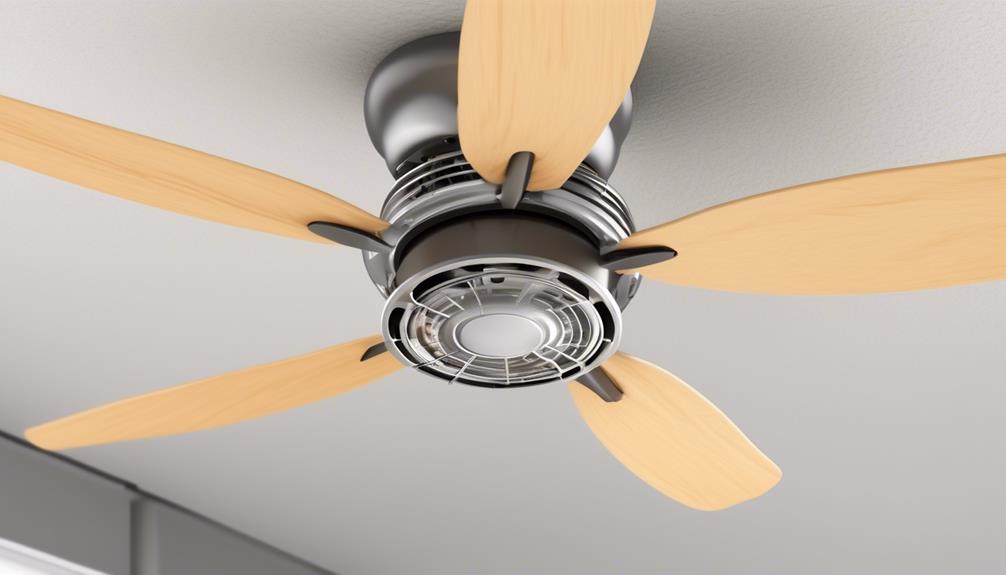
Ceiling fan failures can be caused by a variety of factors, such as improper installation, worn-out motor components, or inadequate maintenance. When it comes to ceiling fan accidents, it’s crucial to identify the common causes of failures to prevent any potential hazards.
Here are some factors that can contribute to ceiling fan failures:
- Improper installation: A poorly installed ceiling fan can result in an unstable or unbalanced fan, which increases the likelihood of it falling or malfunctioning.
- Worn-out motor components: Over time, the motor components of a ceiling fan can deteriorate, leading to reduced performance, excessive noise, or complete failure.
- Inadequate maintenance: Neglecting regular maintenance, such as cleaning and lubricating the fan, can cause dust and debris buildup, which puts additional strain on the motor and can lead to failures.
- Overloading the fan: Exceeding the recommended weight limit of a ceiling fan by adding heavy attachments or using improper mounting hardware can cause stress on the fan and result in failure.
- Electrical issues: Faulty wiring or power surges can cause damage to the motor or other electrical components of the ceiling fan, leading to failures.
To ensure the safety of individuals and prevent ceiling fan accidents, it’s essential to follow proper installation procedures, conduct regular maintenance, and avoid overloading the fan. Additionally, addressing any electrical issues promptly can help maintain the longevity and functionality of your ceiling fan.
The Importance of Regular Maintenance
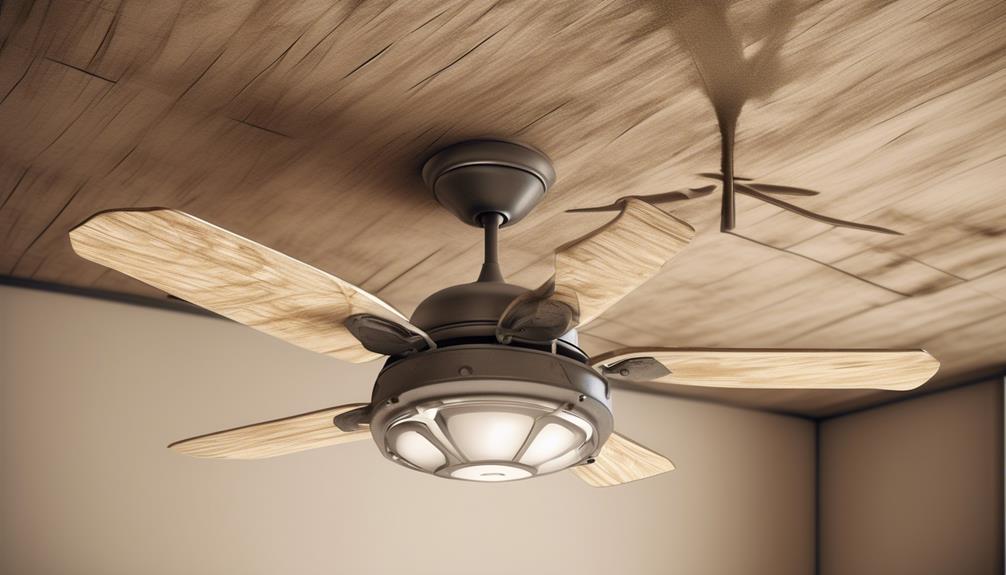
Regular maintenance is crucial when it comes to ceiling fan safety. By performing regular checks and maintenance, we can prevent accidents and ensure the safety of those in the vicinity of the fan.
Maintenance saves lives, and it’s our responsibility to prioritize the regular upkeep of ceiling fans to prevent any potential hazards or failures.
Maintenance Saves Lives
Regular maintenance is crucial for ensuring the safety and longevity of ceiling fans. Neglecting maintenance can lead to various safety hazards and reduce the lifespan of the fan. Here are some key maintenance benefits and safety precautions to keep in mind:
- Cleaning: Regularly clean the fan blades to prevent dust buildup, which can affect performance and cause imbalance.
- Tightening: Check and tighten all screws and bolts to ensure stability and prevent parts from coming loose during operation.
- Lubricating: Apply lubricant to the motor and bearings to reduce friction and prevent overheating.
- Inspecting: Regularly inspect the fan for any signs of damage, such as cracks or loose wires, and promptly address any issues.
- Balancing: Ensure the fan is properly balanced to prevent wobbling, which can lead to mechanical failure or falling.
Preventing Accidents Through Maintenance
Maintaining ceiling fans through regular upkeep is vital for preventing accidents and ensuring optimal safety. Regular maintenance helps identify and address potential issues before they become hazardous and mitigates the risk of accidents caused by faulty components or loose fittings.
A thorough inspection of the fan’s mounting system, blades, and electrical connections should be conducted periodically. The mounting system must be secure and free from any signs of wear or damage. Blades should be cleaned and balanced to prevent wobbling or vibrations that could lead to detachment. Checking and tightening electrical connections is also crucial to prevent electrical hazards.
Additionally, lubricating moving parts and replacing worn-out components will enhance the fan’s performance and longevity. By prioritizing maintenance, homeowners can create a safe environment and reduce the likelihood of accidents caused by ceiling fan malfunctions.
Regular Checks Ensure Safety
By conducting regular checks, homeowners can ensure the safety of their ceiling fans through consistent maintenance. Regular maintenance is crucial to prevent potential hazards and extend the lifespan of the fan. Here are some guidelines to follow:
Understanding fan installation:
- Ensure the fan is securely mounted to the ceiling using the manufacturer’s recommended hardware.
- Verify that the electrical connections are properly installed and grounded to prevent electrical accidents.
Regular maintenance guidelines:
- Dust the fan blades regularly to prevent the accumulation of debris that can affect performance.
- Inspect the fan for any loose screws or bolts and tighten them as necessary.
- Lubricate the fan motor annually to reduce friction and noise.
How Age and Wear Impact Ceiling Fan Safety

Over time, the aging and deterioration of ceiling fans can significantly impact their safety and functionality. It’s crucial to understand how age and wear affect the safety of ceiling fans, especially when it comes to ensuring the well-being of children.
The design of a ceiling fan plays a vital role in its stability, and as it ages, the fan’s structural integrity may weaken, increasing the risk of accidents.
Ceiling fan safety for children is of utmost importance. As fans age, the risk of blades becoming loose or detached increases. This poses a significant hazard, especially in households with young children who may be curious and prone to exploring their surroundings. Additionally, worn-out bearings or motor components can lead to excessive vibrations or wobbling, further compromising the stability of the fan. This instability can result in the fan falling from the ceiling, potentially causing serious injury or damage.
Furthermore, the impact of ceiling fan design on stability can’t be overlooked. Fans with inadequate mounting systems or flimsy construction are more prone to failure over time. It’s crucial to choose a fan with a sturdy and reliable design, ensuring that it can withstand the test of time.
Analyzing Ceiling Fan Mounting Options
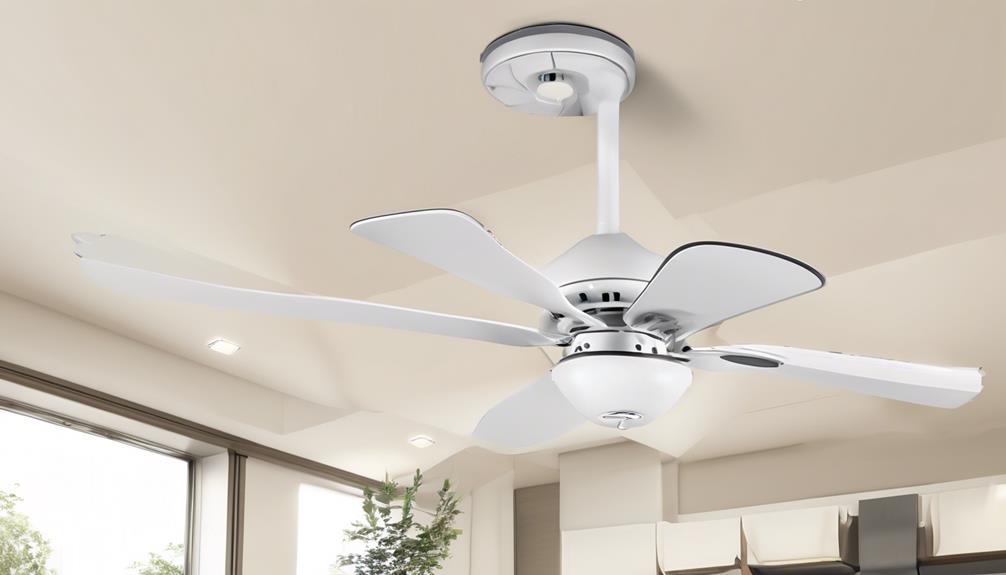
When analyzing ceiling fan mounting options, it’s essential to consider the stability and structural integrity of each option to ensure safe and reliable installation. Proper ceiling fan installation requires secure mounting to prevent any accidents or damage. Here are five important factors to consider when evaluating ceiling fan mounting options:
- Ceiling Joists: Determine if the ceiling joists are strong enough to support the weight of the fan. Look for solid wood joists rather than lightweight or hollow ones.
- Mounting Bracket: Choose a mounting bracket that’s specifically designed for ceiling fans. It should be sturdy and capable of securely holding the weight of the fan.
- Mounting Method: Decide whether to mount the fan directly to the ceiling or use a downrod for additional clearance. Consider the height of the ceiling and the desired airflow when making this decision.
- Hardware and Screws: Ensure that the mounting hardware and screws provided with the fan are appropriate for your ceiling type and have sufficient strength to support the weight of the fan.
- Professional Installation: If you’re unsure about the installation process or lack the necessary tools, it’s advisable to hire a professional electrician or handyman to ensure the fan is properly installed.
The Role of Ceiling Fan Weight in Stability
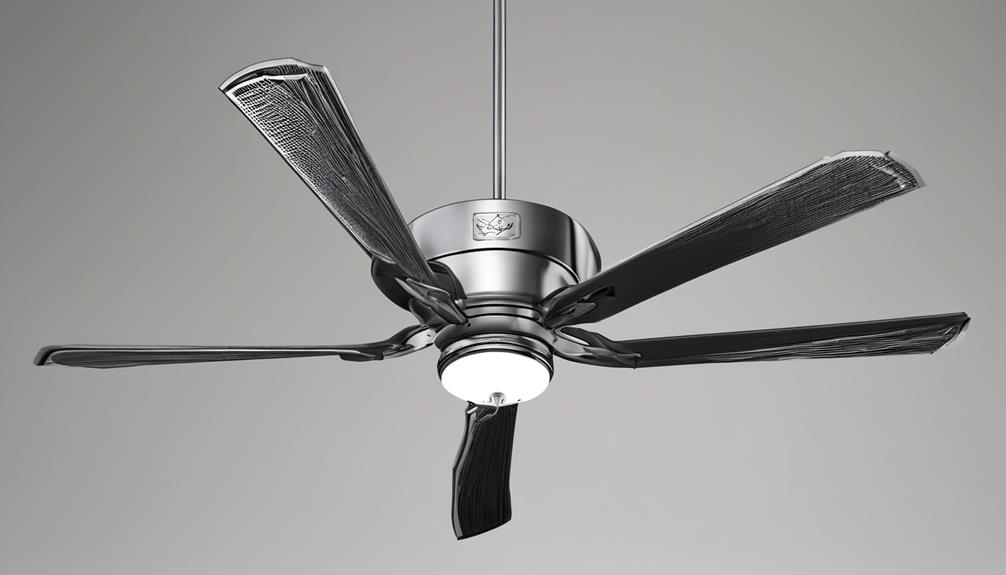
To ensure the stability of a ceiling fan, it’s crucial to consider the weight of the fan as a key factor in the overall stability and structural integrity of the installation. The weight of a ceiling fan directly affects its stability and can be influenced by various factors such as the materials used in its construction and the design of the fan itself. Ceiling fan weight is an important consideration for both residential and commercial installations.
The weight of a ceiling fan plays a significant role in determining its stability. A heavier fan is generally more stable than a lighter one, as it has a lower center of gravity and is less likely to sway or wobble during operation. The weight of the fan also affects the load that the mounting bracket and electrical box must bear. If the fan is too heavy for the ceiling structure to support, it can cause damage to the ceiling or even lead to a catastrophic failure.
When considering the weight of a ceiling fan, it’s essential to take into account the stability factors of the installation. These factors include the type and condition of the ceiling, the strength of the mounting bracket and electrical box, and the quality of the installation itself. It’s important to ensure that the ceiling can support the weight of the fan and that the mounting bracket and electrical box are securely attached to provide adequate support.
Assessing the Quality of Ceiling Fan Components
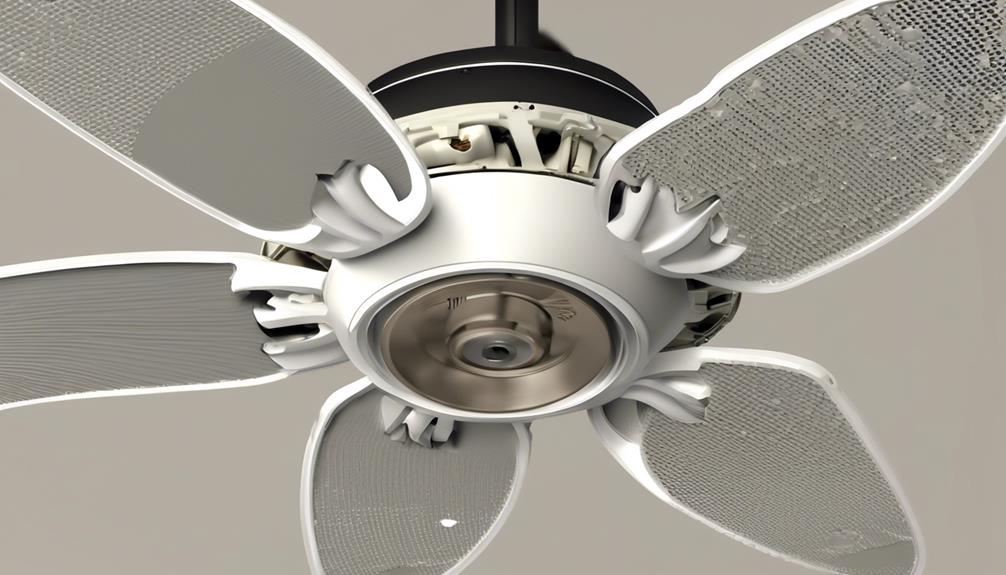
Assessing the quality of ceiling fan components is essential for ensuring the overall performance and longevity of the fan. When evaluating the durability of a ceiling fan, it’s important to consider the following components:
- Motor: The motor is the heart of the ceiling fan and plays a crucial role in its performance. Assessing the motor’s quality involves examining its power output, efficiency, and noise levels. A high-quality motor will provide reliable and efficient operation, ensuring the fan’s durability.
- Blades: The blades of a ceiling fan determine its airflow and efficiency. Evaluating the quality of the blades involves checking for sturdy construction, balanced weight distribution, and aerodynamic design. Well-designed blades can enhance the fan’s performance and reduce energy consumption.
- Mounting bracket: The mounting bracket is responsible for securely holding the fan to the ceiling. It’s crucial to assess the strength and stability of the bracket to prevent any accidents or damage.
- Control mechanism: The quality of the control mechanism, such as pull chains or remote control, determines the ease of use and convenience of operating the fan. Evaluating the control mechanism involves checking for smooth operation, durability, and user-friendly features.
- Housing: The housing of the fan encloses the motor and other internal components. Assessing the quality of the housing involves checking for sturdy construction, proper ventilation, and protection against dust and moisture.
The Impact of Ceiling Fan Speed on Stability
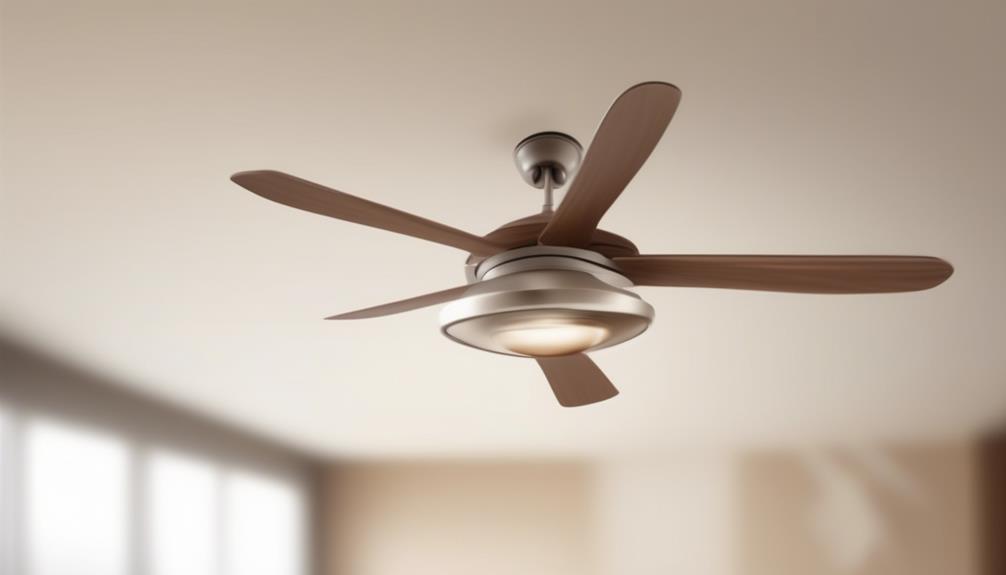
As we continue our exploration of ceiling fan safety, an important aspect to consider is the impact of ceiling fan speed on stability. The speed at which a ceiling fan operates can have significant effects on its stability, and understanding the correlation between speed and stability is crucial for ensuring safe usage.
To better comprehend the relationship between ceiling fan speed and stability, let’s examine the following table:
| Ceiling Fan Speed (RPM) | Stability |
|---|---|
| Low | High |
| Medium | Medium |
| High | Low |
| Very High | Very Low |
| Maximum | Unsafe |
From the table, we can observe that as the fan speed increases, the stability decreases. At low speeds, the fan exhibits high stability, but as the speed increases to medium and high levels, the stability decreases proportionally. At very high speeds, the stability becomes very low, and operating the fan at maximum speed results in an unsafe condition.
It is important to note that the stability of a ceiling fan is affected not only by its speed but also by the quality of its components, as discussed in the previous subtopic. Therefore, it is crucial to ensure both the quality of the components and the appropriate speed setting to maintain a safe and stable ceiling fan operation.
Examining the Effects of Vibration and Oscillation
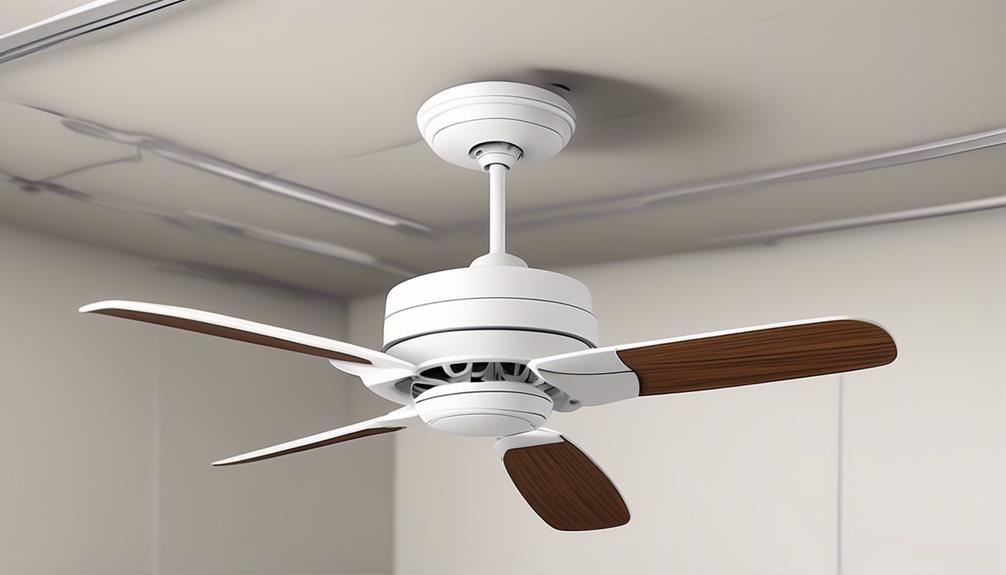
Vibration and oscillation can have significant implications for the stability and safety of a ceiling fan. Understanding the effects of these factors is crucial for ensuring the durability and reliability of the fan.
To analyze and measure the vibration and oscillation of a ceiling fan, several techniques and tools are employed:
- Vibration analysis: This method involves the measurement and analysis of the vibrations produced by the rotating components of the fan. By assessing the frequency, amplitude, and direction of these vibrations, engineers can identify potential issues and make necessary adjustments or repairs.
- Oscillation measurement: Oscillation refers to the back-and-forth movement of the fan blades. Measuring the extent and frequency of this movement helps determine the stability of the fan and whether it’s operating within safe limits.
- Accelerometers: These devices are used to measure the acceleration and vibrations of the fan. They provide valuable data for vibration analysis and help identify any irregularities or excessive vibrations that may compromise the fan’s stability.
- Laser vibrometers: These instruments use laser beams to measure the velocity and displacement of the fan’s components. By analyzing the data obtained from laser vibrometry, engineers can assess the fan’s oscillation characteristics and make informed decisions about its safety.
- Finite element analysis: This technique involves creating computer models of the fan and simulating its vibrations and oscillations. By subjecting the virtual model to different conditions, engineers can identify potential issues and optimize the fan’s design for maximum stability and safety.
The Influence of Room Conditions on Ceiling Fan Safety
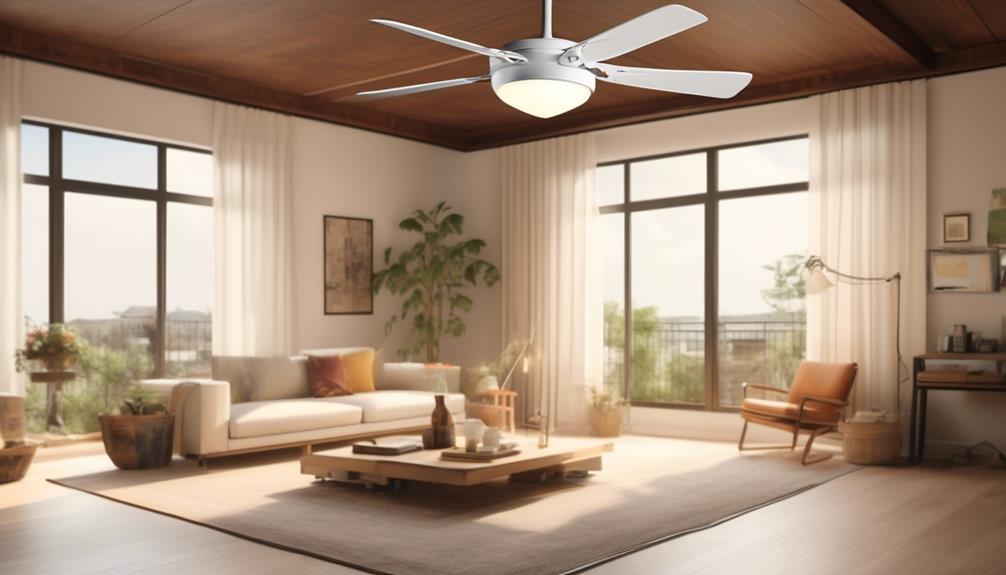
Room conditions play a crucial role in determining the safety of a ceiling fan, as they can impact factors such as airflow, heat dissipation, and structural stability.
One important room condition that affects ceiling fan safety is the room temperature. High room temperatures can put additional stress on the fan motor and increase the risk of overheating. This can lead to malfunctions and potential damage to the fan, increasing the chances of a fan blade falling off. On the other hand, low room temperatures can cause the fan blades to become brittle, making them more prone to breakage. It’s therefore important to maintain a moderate room temperature to ensure the longevity and safety of the ceiling fan.
Another significant factor to consider is the material of the fan blades. Different materials have different levels of durability and resistance to wear and tear. Fan blades made from low-quality materials may be more susceptible to cracking or warping over time, increasing the likelihood of blade detachment. It’s recommended to choose ceiling fans with blades made from sturdy materials such as metal or high-quality plastic to enhance safety.
Tips for Ensuring Ceiling Fan Stability and Peace of Mind
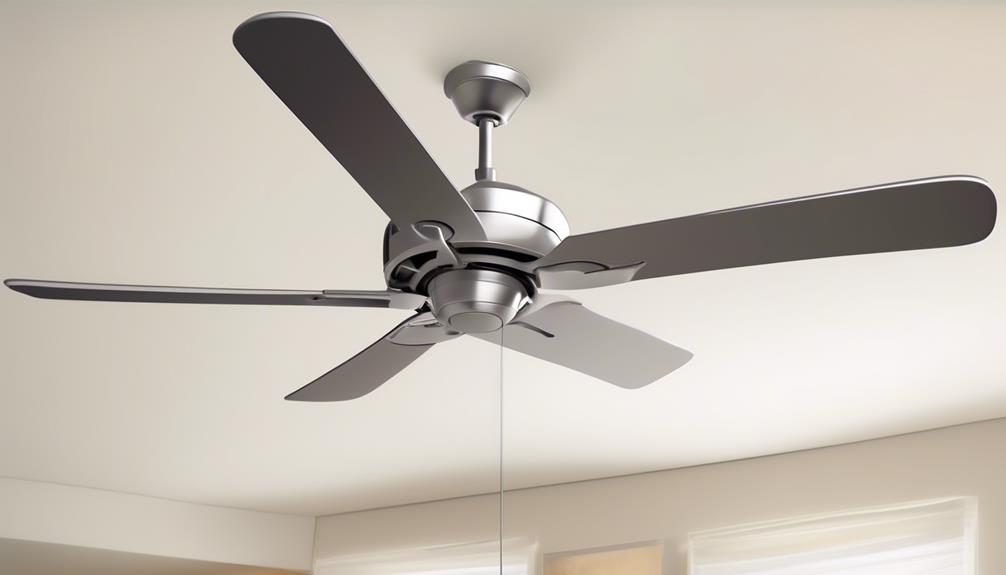
To ensure the stability and peace of mind when it comes to your ceiling fan, it’s essential to take certain precautions and follow specific guidelines. Proper ceiling fan maintenance and securing techniques play a vital role in preventing accidents and ensuring the longevity of your fan.
Here are some tips to help you maintain a stable ceiling fan:
- Regularly inspect the mounting bracket: Check the mounting bracket that attaches the fan to the ceiling for any signs of wear or damage. If you notice any issues, such as cracks or loose screws, it’s important to address them immediately.
- Tighten all connections: Periodically check and tighten all the screws and connections on your ceiling fan. This includes the blades, motor housing, and the mounting bracket. Loose connections can cause the fan to wobble or become unstable.
- Balance the fan: Use a balancing kit to ensure that your ceiling fan is properly balanced. An unbalanced fan can cause excessive vibrations and increase the chances of it falling.
- Use appropriate support: Ensure that your ceiling fan is securely mounted to a ceiling joist or support structure. If necessary, consult a professional to determine the best placement and installation technique for your specific ceiling type.
- Follow manufacturer’s instructions: Always refer to the manufacturer’s instructions for proper installation, maintenance, and safety guidelines. These guidelines are designed to ensure the stability and safe operation of your ceiling fan.
Frequently Asked Questions
Can a Ceiling Fan Fall on You When It Is Turned Off?
It’s important to consider the maintenance of ceiling fans and the common causes of accidents. While turned off, the chances of a ceiling fan falling on you are low, but regular inspections and proper installation can further reduce any potential risk.
Is It Safe to Install a Ceiling Fan in a Room With Low Ceilings?
Installing a ceiling fan in a room with low ceilings can be safe if done correctly. The ceiling fan installation process should consider the height and clearance requirements. Benefits of ceiling fans in rooms with low ceilings include improved air circulation and energy efficiency.
How Often Should I Check and Tighten the Screws on My Ceiling Fan?
When checking and tightening screws on a ceiling fan, it is crucial to ensure the fan is securely attached. Proper installation, selecting the right size fan, and identifying common causes of wobbling are essential for safety.
Can Using a Ceiling Fan at High Speeds Increase the Chances of It Falling?
Using a ceiling fan at high speeds can increase the chances of it falling. Regular ceiling fan maintenance, including checking and tightening screws, is crucial to prevent potential dangers associated with ceiling fan usage.
What Are Some Signs That Indicate My Ceiling Fan May Be Becoming Unstable?
We’ve noticed some signs of instability with our ceiling fan. It wobbles and makes unusual noises. We’ve learned that regular maintenance, like tightening screws and checking for loose parts, can help ensure its stability.
Conclusion
In conclusion, ensuring ceiling fan stability is crucial to prevent any potential accidents.
By following proper installation guidelines, conducting regular maintenance, and considering factors such as fan speed, vibration, and room conditions, you can minimize the chances of a ceiling fan falling on you.
Just like a well-engineered machine, a securely installed ceiling fan can bring comfort and peace of mind to your living space.
- About the Author
- Latest Posts
Introducing Ron, the home decor aficionado at ByRetreat, whose passion for creating beautiful and inviting spaces is at the heart of his work. With his deep knowledge of home decor and his innate sense of style, Ron brings a wealth of expertise and a keen eye for detail to the ByRetreat team.
Ron’s love for home decor goes beyond aesthetics; he understands that our surroundings play a significant role in our overall well-being and productivity. With this in mind, Ron is dedicated to transforming remote workspaces into havens of comfort, functionality, and beauty.
Garage Door Opener
What Makes a Fingerprint Garage Door Opener Secure?
Secure your garage with cutting-edge fingerprint technology – but is it truly foolproof?

In the realm of security, it is commonly said that it is better to prevent than to cure.
When it comes to fingerprint garage door openers, the question of what truly makes them secure lingers in our minds.
The intricate technology behind these devices promises a blend of convenience and protection, but how reliable are they in safeguarding our homes?
Let's explore the layers of security measures embedded in these biometric systems that promise to keep our garage access exclusive and our belongings safe.
Key Takeaways
- Cutting-edge encryption technology safeguards biometric data integrity
- Unique fingerprint analysis ensures secure access control
- Robust data storage mechanisms encrypt and protect sensitive information
- Anti-spoofing measures prevent unauthorized entry attempts
Advanced Encryption Technology
Using cutting-edge encryption technology, we ensure the utmost security of biometric data in fingerprint garage door openers. Encryption algorithms play a crucial role in protecting the fingerprint templates stored within the system, ensuring that sensitive information remains safeguarded from unauthorized access.
Biometric access control systems rely on secure communication protocols to maintain data integrity and prevent any potential breaches. By implementing robust encryption key management practices, we enhance the overall security posture of the garage door opener, mitigating the risks associated with unauthorized data exposure.
Strong encryption standards such as the Advanced Encryption Standard (AES) are commonly employed to fortify the security of biometric authentication processes, providing users with a reliable and liberating experience.
Through the effective integration of encryption technology and secure communication protocols, we prioritize the confidentiality and integrity of fingerprint data, offering a seamless and secure access control solution for modern garage door systems.
Biometric Authentication Process

Utilizing the distinct biological features of fingerprints, the biometric authentication process in fingerprint garage door openers meticulously analyzes individual fingerprint patterns to verify user identities, ensuring secure access control. The biometric fingerprint scanner captures the unique ridges and valleys of a person's fingerprint, converting them into a digital template for comparison. This process allows only registered users with pre-scanned fingerprints to unlock the garage door, enhancing security measures. The high level of accuracy in matching fingerprints provides reliable access control, significantly reducing the risk of unauthorized entry. Compared to traditional methods like keypads or remotes, biometric authentication offers a more robust security solution by relying on the inherent uniqueness of each person's fingerprints. Here is a table to summarize the key points of the biometric authentication process in fingerprint garage door openers:
| Biometric Authentication Process |
|---|
| Utilizes distinct fingerprint features |
| Analyzes individual fingerprint patterns |
| Verifies user identities |
| Ensures secure access control |
| Provides high level of security |
Secure Data Storage Mechanism
Moving from the biometric authentication process, our focus now shifts to the secure data storage mechanism employed in fingerprint garage door openers to safeguard biometric information.
Fingerprint garage door openers use secure data storage mechanisms to ensure that biometric data is kept safe from unauthorized access. Instead of storing fingerprint templates as plain images, complex mathematical representations are utilized for enhanced security. The biometric data is encrypted and stored either on the device itself or in a cloud server, employing advanced encryption techniques to protect user privacy.
To further enhance security, advanced measures such as hashing and salting are implemented to safeguard the fingerprint data from potential breaches or cyber attacks. Hashing converts the fingerprint data into a unique string of characters, while salting adds extra random data to the process, making it even more secure.
Continuous monitoring and regular updates to security protocols are crucial to maintaining the integrity of the stored fingerprint information in garage door openers. These measures collectively contribute to ensuring the secure storage and protection of sensitive biometric data in fingerprint garage door openers.
Anti-Spoofing Measures

Our implementation of anti-spoofing measures in fingerprint garage door openers significantly enhances security by detecting and preventing unauthorized access through advanced biometric technology. Keyless locks on garage doors are safeguarded by anti-spoofing features that ensure only genuine fingerprints are recognized for access.
To achieve this, cutting-edge algorithms and sensors are utilized to distinguish real fingerprints from replicas, adding layers of security against unauthorized entry attempts. By incorporating these anti-spoofing measures, the garage door opener system becomes more resilient to unauthorized access, providing users with peace of mind regarding the protection of their property.
These measures go beyond traditional security methods, offering a sophisticated solution to prevent unauthorized individuals from gaining access to the garage. Overall, the integration of anti-spoofing technology into fingerprint garage door openers enhances their security capabilities, making them a reliable and secure choice for homeowners seeking advanced access control mechanisms.
Remote Access Security Features
Remote access security features in fingerprint garage door openers employ advanced biometric authentication to ensure only authorized fingerprints can trigger the garage door opening remotely. This technology adds a robust layer of protection, preventing unauthorized access to the garage. By requiring a unique fingerprint scan for remote access, these systems effectively thwart unauthorized entry attempts. The table below highlights the key aspects of remote access security features in fingerprint garage door openers:
| Feature | Description |
|---|---|
| Biometric Security | Utilizes fingerprints to authenticate and allow access to the garage |
| Control Panel Access | Some systems offer remote access through a control panel inside the garage |
| Garage Door Opening | Enables users to open the garage door remotely with authorized fingerprints |
| Secure Access | Ensures only authorized individuals have access to the garage |
These security measures provide peace of mind by enhancing the overall security of your garage door system.
Frequently Asked Questions
How Secure Are Keypad Garage Door Openers?
Keypad garage door openers offer a secure method of accessing garages without keys or remotes. Users can create personalized PIN codes for entry, adding an extra layer of security.
These systems can store multiple access codes, making it easy to manage authorized users. The convenience of keypad entry eliminates the risk of lost or stolen keys.
Keypad garage door openers are cost-effective and dependable security solutions for modern homes.
Are Smart Garage Door Openers Secure?
We've explored the security of smart garage door openers. These systems provide advanced protection through biometric authentication, ensuring only authorized users can access the garage.
Integration with SmartThings offers tailored security solutions, leveraging fingerprint readers for keyless entry.
With these features, smart garage door openers enhance security measures, making them a reliable choice for safeguarding your property.
How Does a Fingerprint Door Lock Work?
Fingerprint door locks work by scanning and storing unique fingerprint patterns as access credentials. These locks utilize biometric technology to authenticate users based on their fingerprints, which are highly secure due to their uniqueness.
When a user tries to gain entry, the lock compares the scanned fingerprint with stored data to either grant or deny access. This method offers convenience and enhanced security compared to traditional key-based or code-based locks.
How Can I Make My Garage Door More Secure?
To enhance our garage door security, we prioritize utilizing advanced biometric technology like fingerprint locks. These locks provide exclusive access control and deter unauthorized entry effectively.
Conclusion
In conclusion, the fingerprint garage door opener's security is bolstered by advanced encryption technology, biometric authentication processes, secure data storage mechanisms, anti-spoofing measures, and remote access security features.
Like a fortress guarded by vigilant sentinels, these sophisticated security measures ensure that only authorized individuals can access the garage, providing peace of mind and protection for homeowners.
The integration of biometric locks with existing security systems creates a robust defense against unauthorized access, making the fingerprint garage door opener a secure and convenient choice for modern homes.
- About the Author
- Latest Posts
Introducing Ron, the home decor aficionado at ByRetreat, whose passion for creating beautiful and inviting spaces is at the heart of his work. With his deep knowledge of home decor and his innate sense of style, Ron brings a wealth of expertise and a keen eye for detail to the ByRetreat team.
Ron’s love for home decor goes beyond aesthetics; he understands that our surroundings play a significant role in our overall well-being and productivity. With this in mind, Ron is dedicated to transforming remote workspaces into havens of comfort, functionality, and beauty.
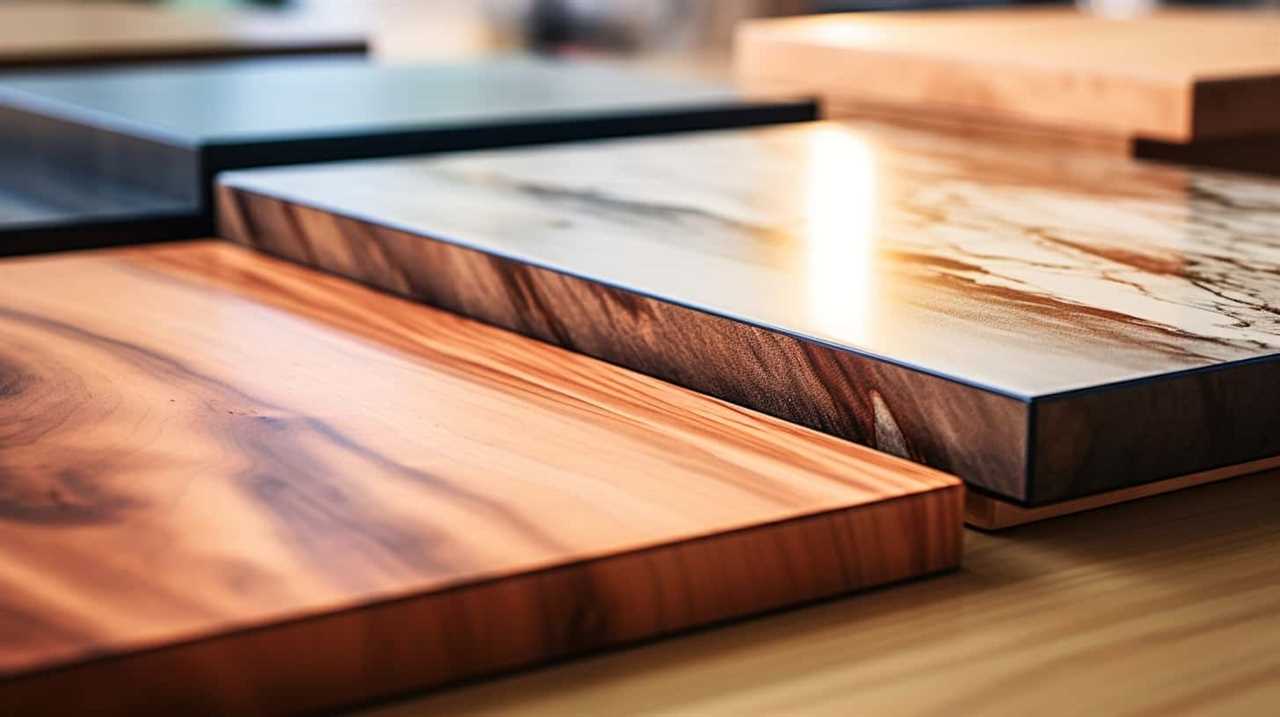
Are you fed up with inconsistent heating and cooling throughout your house? Look no further – we have the perfect solution for you!
In this guide, we will walk you through 9 simple steps to resolve this common HVAC issue.
You may not know this, but there are various factors that can contribute to uneven temperatures throughout your home. By following our expert advice, you’ll be able to identify and address these issues like a pro.
From checking air filters and inspecting ductwork for leaks to adjusting thermostat settings and considering a zoning system installation, we’ve got you covered.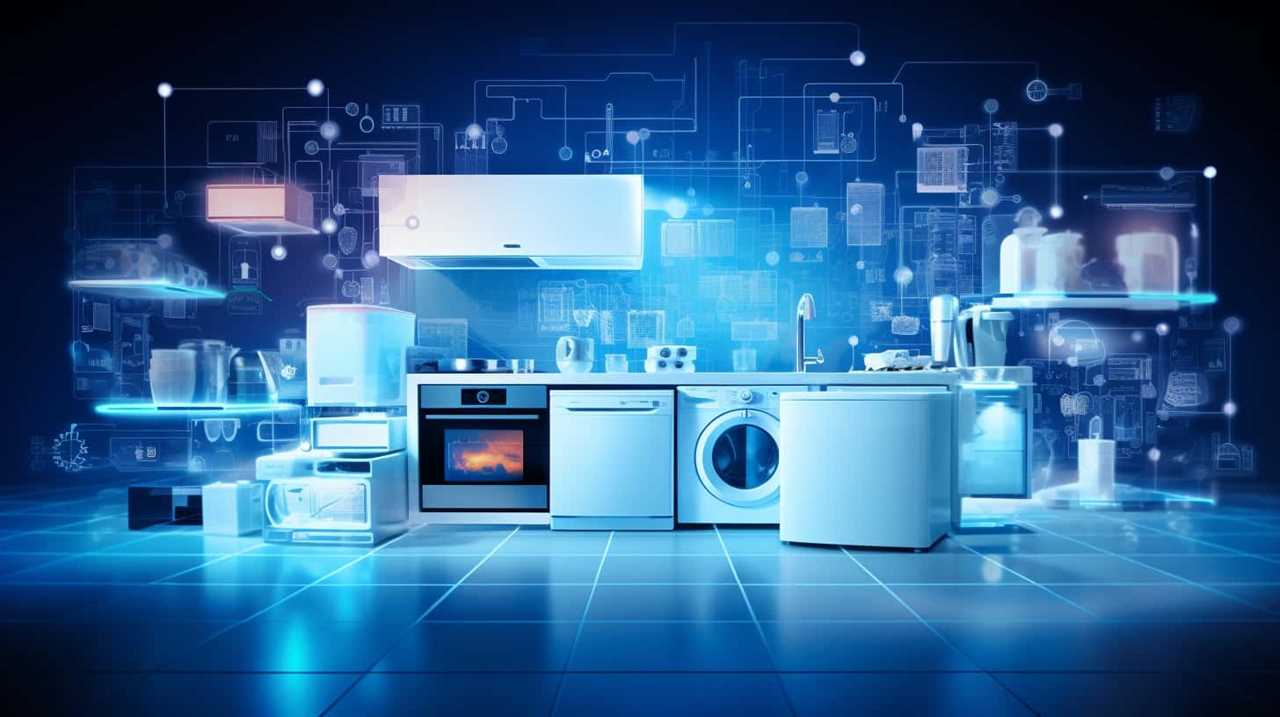
Say goodbye to hot and cold spots, and say hello to a perfectly balanced indoor climate.
Get ready to master your HVAC system and enjoy ultimate comfort all year round!
Key Takeaways
- Regular maintenance and inspection, such as checking air filters and inspecting ductwork, can help identify and resolve issues that may be causing uneven heating and cooling.
- Proper insulation is important for maintaining temperature control and reducing heat transfer, which can help address uneven heating and cooling.
- Adjusting thermostat settings, including temperature zoning and fan speed, can help achieve more even temperature distribution throughout the space.
- Upgrading insulation materials and adding insulation to attics, walls, and floors can improve energy efficiency and create a more comfortable living environment by addressing uneven heating and cooling.
Check Air Filters
We should start by checking our air filters to resolve uneven HVAC heating and cooling. Air filter maintenance is essential for proper functioning of your HVAC system. Over time, air filters accumulate dust, dirt, and other particles, which can obstruct the airflow and compromise the efficiency of the system. To maintain optimal performance, it’s recommended to replace air filters regularly, typically every 1 to 3 months, depending on usage and the type of filter. Neglecting filter replacement can result in reduced airflow, increased energy consumption, and even system breakdowns.
To check your air filters, locate the filter compartment, usually found near the air handler or furnace. Turn off the system before removing the filter. Inspect the filter for dirt and debris accumulation. If the filter appears dirty or clogged, it’s time for a replacement. When replacing the filter, ensure you select the correct size and type for your HVAC system. High-efficiency filters may provide better air quality, but they may also restrict airflow if not compatible with your system. Consult the manufacturer’s recommendations or seek professional advice if unsure.
By regularly maintaining and replacing your air filters, you can improve the performance and longevity of your HVAC system. Moreover, addressing air filter issues is just the first step towards achieving balanced heating and cooling.
Now, let’s move on to the next section and inspect the ductwork for leaks.
Inspect Ductwork for Leaks
Now let’s examine the ductwork for any potential leaks. Inspecting the ductwork thoroughly is crucial in resolving uneven HVAC heating and cooling. Leaky ducts can lead to significant energy loss and reduced system efficiency, resulting in uneven temperature distribution throughout your home or building.
To inspect the ductwork, start by visually examining the ducts for any visible signs of damage or disconnection. Look for loose connections, holes, cracks, or gaps in the ducts. Pay close attention to joints, bends, and areas where the ducts connect to the registers or air handler.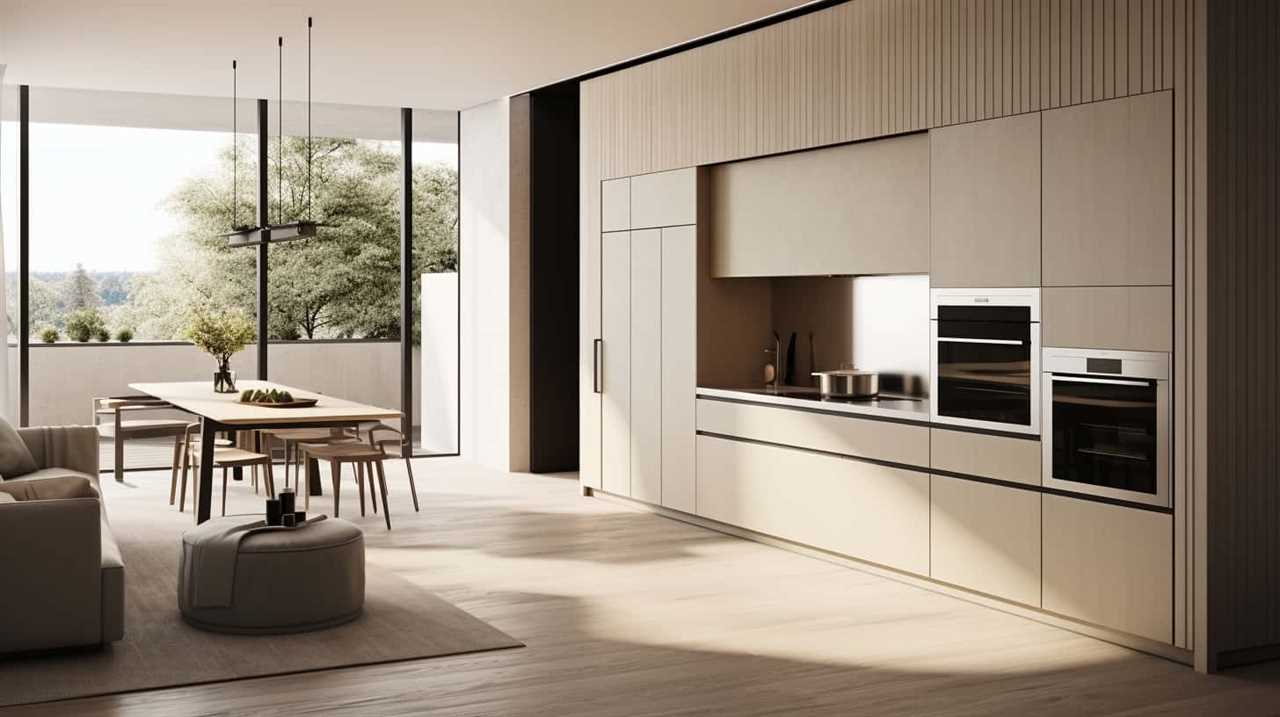
After a visual inspection, it’s important to perform a more detailed assessment using ductwork repair techniques. One effective method is the smoke test, where smoke is blown into the ducts to identify any leaks. Another technique involves using an infrared camera to detect temperature variations along the ducts, indicating potential air leaks.
Once the leaks are identified, ductwork repair techniques can be employed to fix them. These techniques may include sealing the leaks with duct tape or mastic sealant, or replacing damaged sections of the ductwork altogether.
Balance Air Registers
To achieve optimal HVAC performance and resolve uneven heating and cooling, it’s essential to balance the air registers throughout your home or building. Proper airflow balance and register placement play a crucial role in maintaining a comfortable indoor environment. Here are three key considerations to keep in mind:
- Evaluate register locations: Assess the placement of air registers in each room to ensure they’re positioned strategically. Ideally, registers should be located near windows or exterior walls to promote efficient air circulation. Additionally, ensure that furniture or obstructions aren’t blocking the registers, as this can impede airflow.
- Adjust damper settings: Most air registers are equipped with dampers that allow you to control the amount of air flowing into a room. By adjusting the damper settings, you can redirect airflow to areas that require more heating or cooling. This helps to balance the temperature throughout your home or building.
- Consider zoning systems: If you have a larger space or multiple floors, implementing a zoning system can further enhance airflow balance. This system allows you to divide your home into different zones, each with its own thermostat and separate control over airflow. By individually regulating the temperature in each zone, you can optimize comfort and energy efficiency.
Clean and Maintain Outdoor Unit
After evaluating register locations and adjusting damper settings, it’s important to clean and maintain the outdoor unit of your HVAC system to ensure optimal performance. Outdoor unit maintenance plays a crucial role in the overall functionality and efficiency of your HVAC system. Neglecting proper cleaning and maintenance can lead to common maintenance mistakes that can impact the system’s performance and lifespan.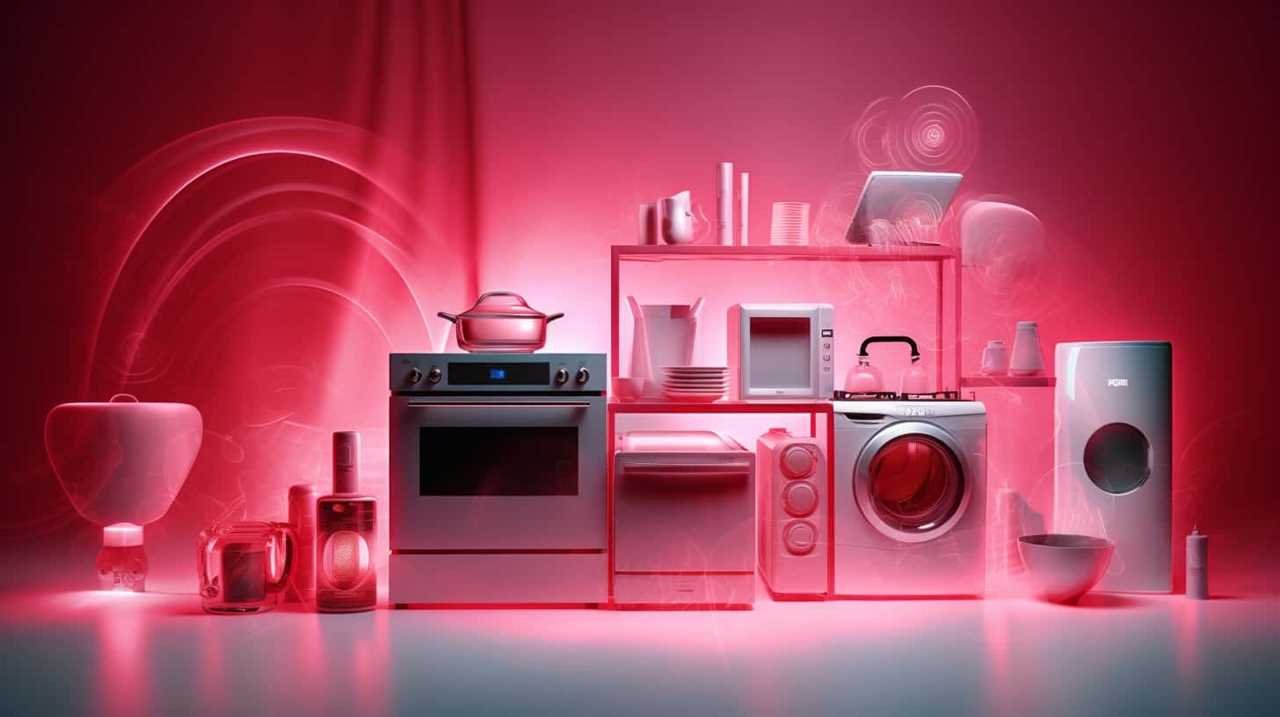
Regularly cleaning the outdoor unit is essential to remove dirt, debris, and leaves that can accumulate on the unit’s coils, fins, and fan blades. These contaminants can hinder proper airflow and reduce the unit’s efficiency. Using a soft brush or vacuum cleaner, gently remove any debris from the fins and coils. Be cautious not to damage the delicate fins during the cleaning process.
Another important aspect of outdoor unit maintenance is inspecting and cleaning the condenser coils. Over time, these coils can become dirty and clogged, affecting the unit’s ability to transfer heat. Use a coil cleaner or a mild detergent mixed with water to clean the coils, ensuring they’re free from dirt and grime.
Additionally, it’s crucial to trim any vegetation or overgrown plants around the outdoor unit. Plants or shrubs too close to the unit can obstruct airflow and impede proper heat dissipation. Maintain a clearance of at least two feet around the unit to allow adequate airflow and prevent any potential damage.
Ensure Proper Insulation
Proper insulation plays a crucial role in maintaining temperature control within a building. It helps to prevent heat transfer, ensuring that the desired temperature is maintained throughout the space.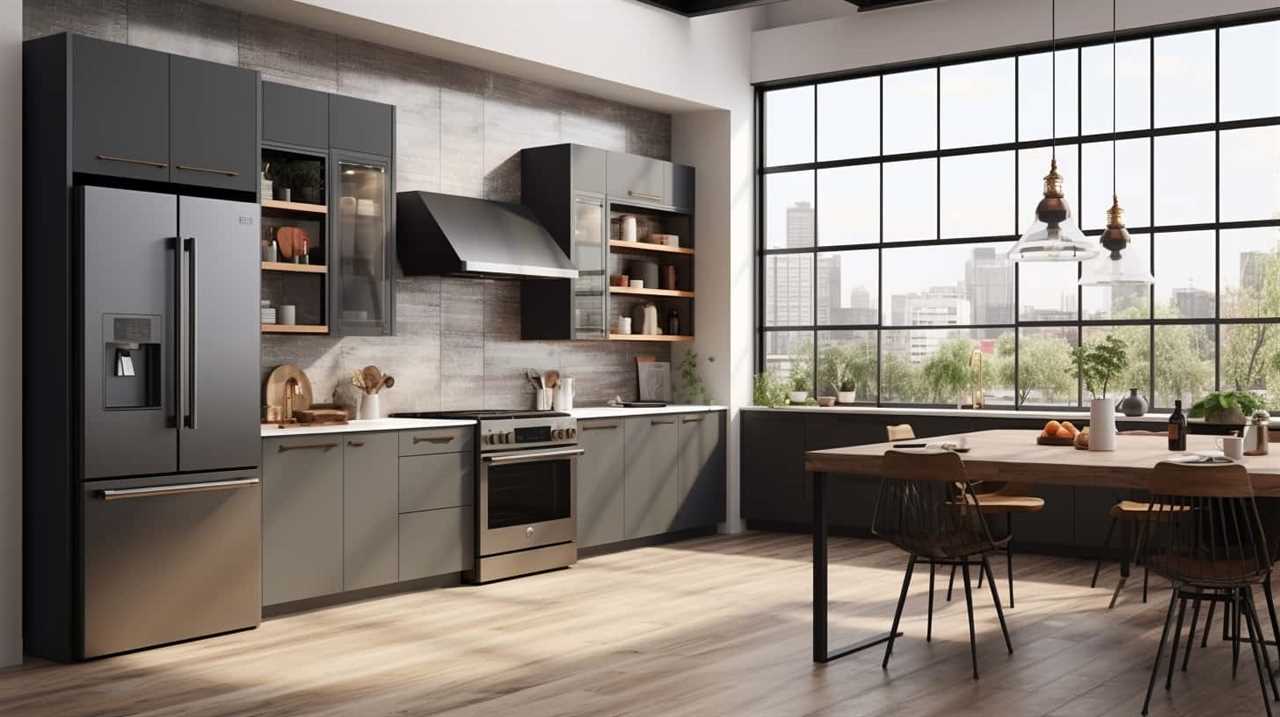
Inadequate insulation can lead to uneven heating and cooling, as well as increased energy consumption.
Insulation and Temperature Control
We frequently check and maintain proper insulation to ensure optimal temperature control in our HVAC system. Insulation plays a crucial role in maintaining a consistent and comfortable temperature inside our homes. Here are three key benefits of proper insulation:
- Energy efficiency: Proper insulation helps to reduce heat transfer between the interior and exterior of our home. By minimizing the amount of heat that escapes during winter and enters during summer, we can significantly reduce our energy consumption. This not only lowers our utility bills but also reduces our carbon footprint.
- Improved comfort: Good insulation ensures that the temperature remains consistent throughout our living spaces. It prevents drafts, cold spots, and heat loss, creating a more comfortable environment for us and our families.
- Noise reduction: Insulation also acts as a sound barrier, reducing the transmission of noise from outside to inside our homes. This helps create a quieter and more peaceful living environment.
Proper insulation is crucial for achieving efficient temperature control and overall comfort in our HVAC system. By ensuring that our homes are adequately insulated, we can enjoy the benefits of energy efficiency, improved comfort, and reduced noise levels.
Importance of Insulation
Ensuring proper insulation is an essential step in resolving uneven HVAC heating and cooling. Insulation acts as a barrier that prevents the transfer of heat between the inside and outside of a building. By installing the right type of insulation, you can create a more consistent and comfortable indoor environment. There are several types of insulation available, including fiberglass, cellulose, and spray foam. Each type has its own benefits and considerations, such as cost, R-value, and installation requirements.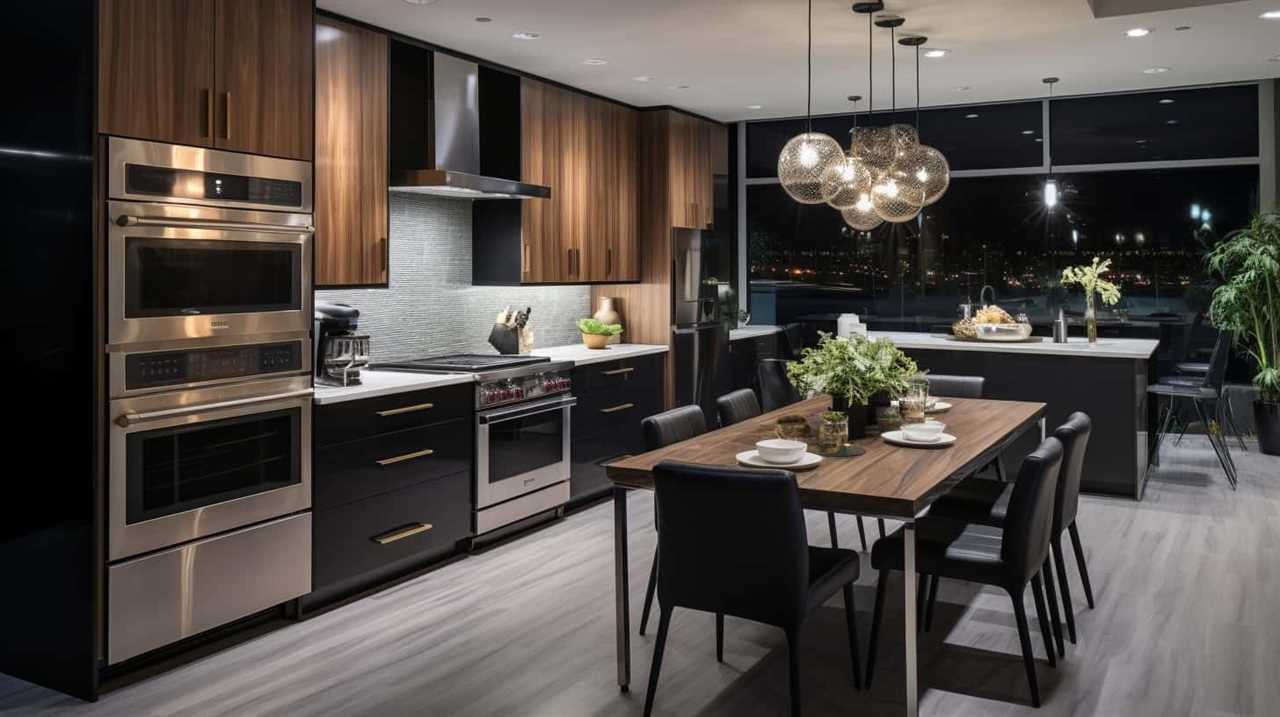
To emphasize the importance of insulation, let’s take a look at the benefits it provides:
| Benefits of Insulation |
|---|
| Reduced energy costs |
| Improved comfort |
| Enhanced indoor air quality |
Insulation helps to reduce energy costs by minimizing heat loss or gain, allowing your HVAC system to work more efficiently. It also improves comfort by maintaining a more stable temperature throughout your home. Additionally, insulation can contribute to better indoor air quality by reducing the infiltration of outside pollutants. Therefore, it is crucial to ensure that your building has proper insulation to achieve optimal HVAC performance and overall comfort.
Adjust Thermostat Settings
To resolve uneven HVAC heating and cooling, there are several points to consider when adjusting thermostat settings.
One technique is temperature zoning, which allows for different temperatures in different areas of the house.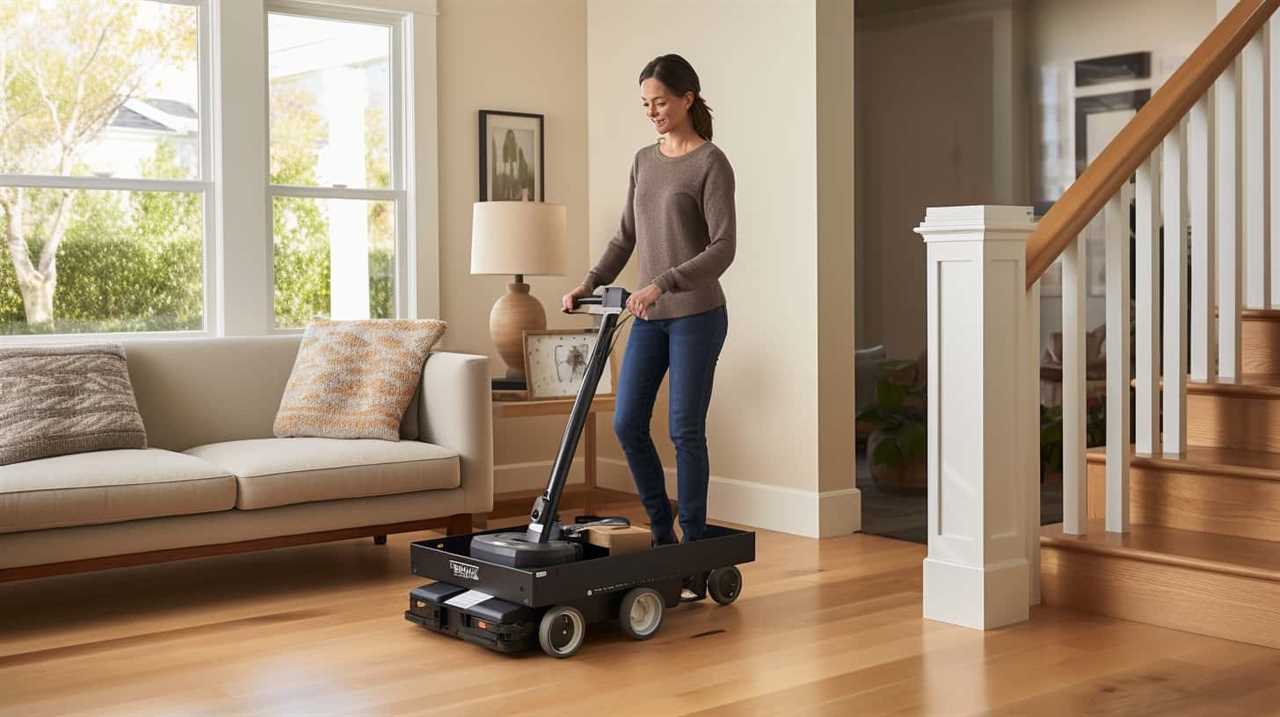
Adjusting the fan speed can also help distribute air more evenly.
Additionally, upgrading insulation can prevent heat loss or gain, improving overall temperature control.
Temperature Zoning Techniques
By adjusting thermostat settings, we can effectively implement temperature zoning techniques to address uneven HVAC heating and cooling. Here are three temperature zoning techniques that can help optimize temperature control and improve energy efficiency:
- Programmable Thermostats: By setting different temperature zones throughout your home or building, programmable thermostats allow you to customize heating and cooling schedules based on occupancy patterns. This ensures that rooms are only heated or cooled when needed, resulting in energy savings.
- Zone Dampers: Zone dampers are installed within the ductwork of a HVAC system to control the airflow to different areas or zones. By adjusting the dampers, you can direct more heated or cooled air to specific zones, ensuring even temperature distribution and comfort throughout the space.
- Smart HVAC Systems: Smart HVAC systems use sensors and advanced algorithms to monitor and adjust temperature settings based on occupancy, weather conditions, and user preferences. These systems can automatically adapt to changing conditions, optimizing energy usage and providing personalized comfort.
Implementing these temperature zoning techniques can help resolve uneven HVAC heating and cooling, providing better temperature control and improving energy efficiency.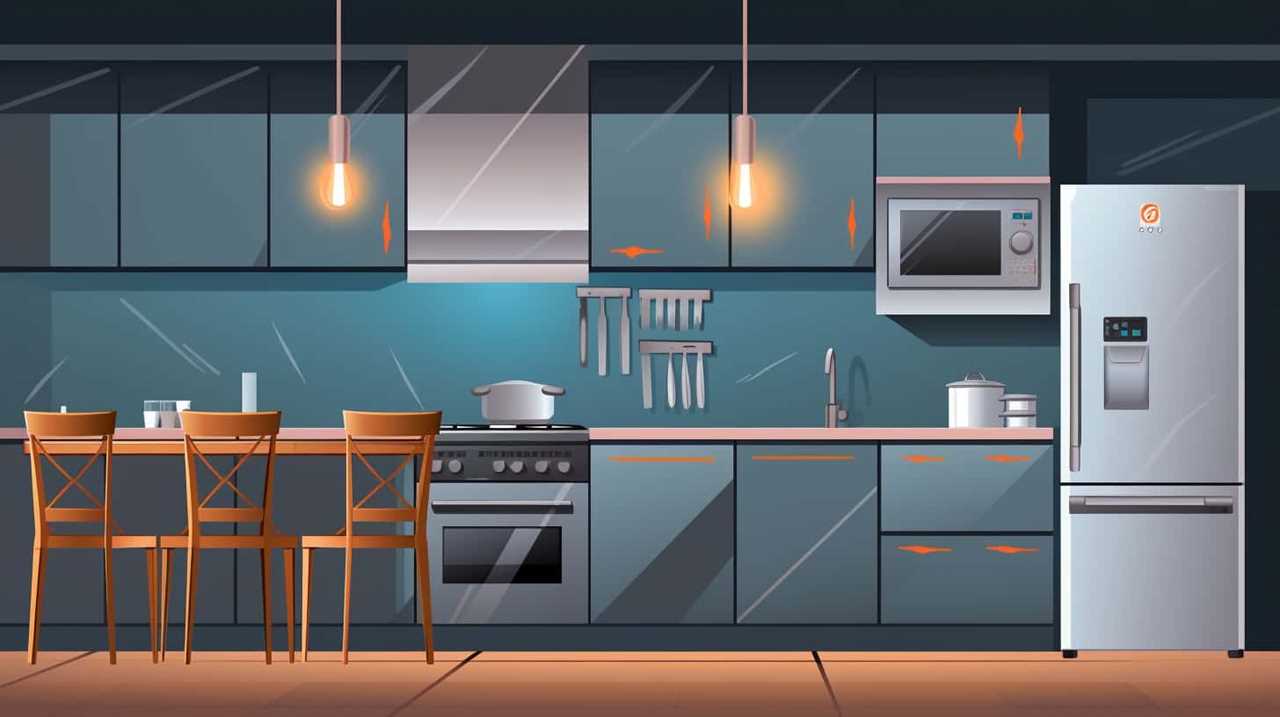
Fan Speed Adjustment
We can optimize temperature control and improve energy efficiency by adjusting the thermostat settings for fan speed. Fan speed optimization is an effective way to ensure an even distribution of conditioned air throughout your home. By controlling the fan speed, you can regulate the amount of air being circulated, preventing hot or cold spots. Adjusting the fan speed can also help reduce energy consumption and lower utility bills. Here is a table outlining the different fan speed settings and their corresponding benefits:
| Fan Speed Setting | Benefits |
|---|---|
| Low | Energy efficiency, reduced noise |
| Medium | Balanced comfort and energy usage |
| High | Rapid cooling or heating, improved air circulation |
Consider Insulation Upgrades
To further enhance the efficiency of our HVAC system, it’s important to consider insulation upgrades and adjust the thermostat settings. Insulation plays a crucial role in maintaining the desired temperature inside our homes and preventing heat loss or gain. Here are three key reasons why insulation upgrades contribute to improved energy efficiency:
- Enhanced Insulation Effectiveness: Upgrading insulation materials, such as adding insulation to attics, walls, and floors, can significantly improve their effectiveness in preventing heat transfer. This helps to maintain a consistent temperature throughout the house and reduces the workload on the HVAC system.
- Reduced Energy Consumption: By improving insulation, we can minimize the amount of energy required for heating or cooling our homes. This leads to lower utility bills and reduces our carbon footprint.
- Increased Comfort: Proper insulation ensures a more comfortable living environment by minimizing drafts, cold spots, and temperature fluctuations. It allows our HVAC system to operate more efficiently, providing consistent heating and cooling throughout the day.
Consider Zoning System Installation
When addressing the issue of uneven HVAC heating & cooling, it is important to consider the installation of a zoning system. A zoning system allows for the division of a home into different zones, each with its own temperature control. This ensures that each zone receives the appropriate amount of heating or cooling, resulting in a more comfortable living environment and potentially reducing energy costs.
One of the main benefits of a zoning system is the ability to customize the temperature in different areas of the home. This is especially useful in larger homes or multi-story buildings where different areas may have varying temperature needs. By installing a zoning system, homeowners can avoid wasting energy by heating or cooling unoccupied rooms.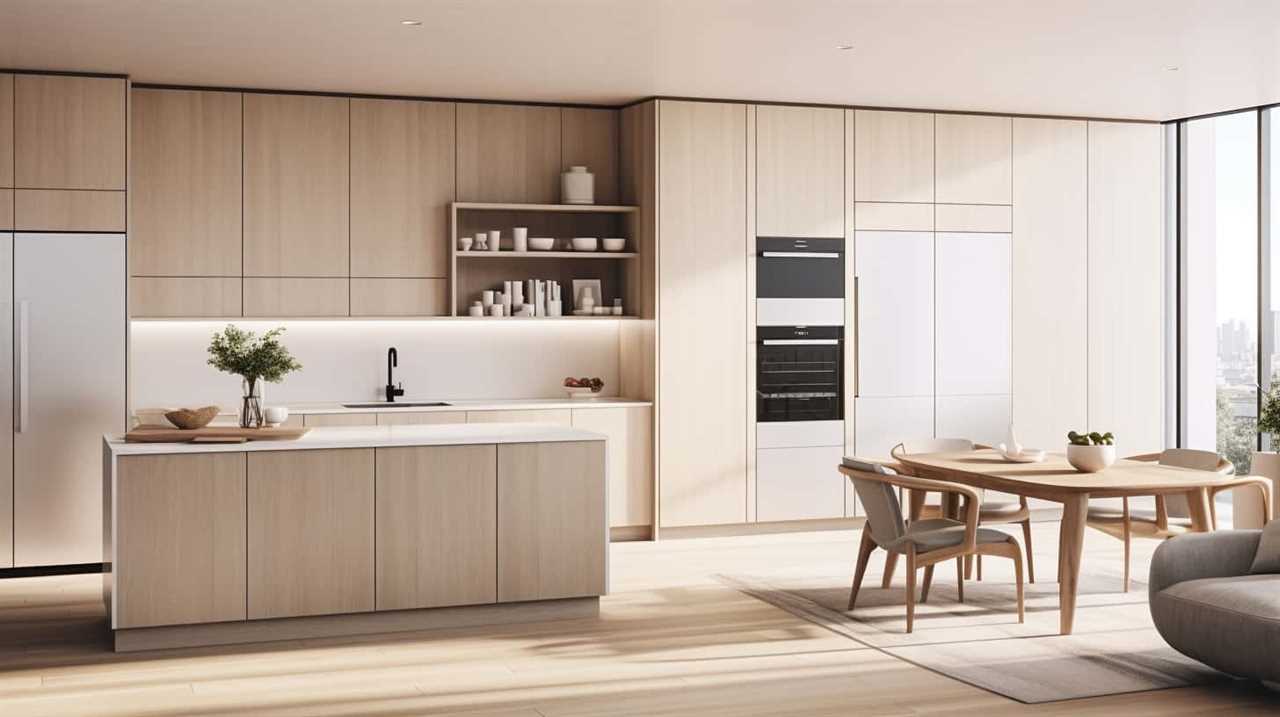
Another advantage of a zoning system is the potential for energy savings. With traditional HVAC systems, the entire home is heated or cooled to the same temperature, even if certain areas don’t require it. By only heating or cooling the zones that are in use, a zoning system can help reduce energy consumption and lower utility bills.
However, it is important to consider the costs associated with installing a zoning system. The upfront investment can be significant, as it involves installing dampers and separate thermostats for each zone. Additionally, professional installation may be required, adding to the overall cost.
In summary, a zoning system offers the benefits of customizable temperature control and potential energy savings. While the initial costs may be higher, the long-term benefits make it a worthwhile consideration for addressing uneven HVAC heating & cooling.
| Zoning System Benefits | Zoning System Costs |
|---|---|
| Customizable temperature control | Significant upfront investment |
| Energy savings | Professional installation may be required |
| More comfortable living environment | Additional costs for dampers and thermostats |
Schedule Regular HVAC Maintenance
Regular HVAC maintenance is essential for ensuring optimal performance and addressing any issues that may cause uneven heating and cooling. By scheduling regular maintenance, you can improve the efficiency of your HVAC system and prevent potential problems from arising. Here are three reasons why regular maintenance is crucial:
- Preventive Maintenance: Regular HVAC maintenance allows technicians to identify and address any potential issues before they become major problems. This helps to avoid unexpected breakdowns and costly repairs, ensuring that your system operates smoothly.
- Improved Efficiency: Over time, HVAC systems can accumulate dirt, dust, and debris, which can hinder their performance and reduce their efficiency. Regular maintenance includes cleaning vital components, such as air filters and coils, to ensure proper airflow and maximize energy efficiency.
- Extended Lifespan: Just like any other mechanical system, regular maintenance can extend the lifespan of your HVAC system. By keeping all components in good working condition, you can prolong the life of your equipment, saving you money on premature replacements.
Consult a Professional for Further Assistance
After scheduling regular HVAC maintenance, we can consult a professional for further assistance with resolving uneven heating and cooling. While regular maintenance can help prevent issues, there may be instances where professional recommendations and troubleshooting tips are needed to address specific problems. A professional can provide expert advice and guidance based on their knowledge and experience in HVAC systems.
When consulting a professional, it’s important to provide them with detailed information about the issue you’re experiencing. This can help them diagnose the problem more accurately and provide targeted solutions. They may also perform additional tests and inspections to identify any underlying issues that may be causing the uneven heating and cooling.
Professional recommendations may include adjustments to the HVAC system settings, such as thermostat calibration or airflow adjustments. They may also suggest repairs or replacements of faulty components, such as ductwork or air filters. In some cases, they may recommend upgrading the HVAC system to a more efficient model to improve overall performance and energy efficiency.
Troubleshooting tips provided by professionals can help you address minor issues on your own. This may include checking and cleaning air vents, ensuring proper insulation in your home, and regular filter replacement.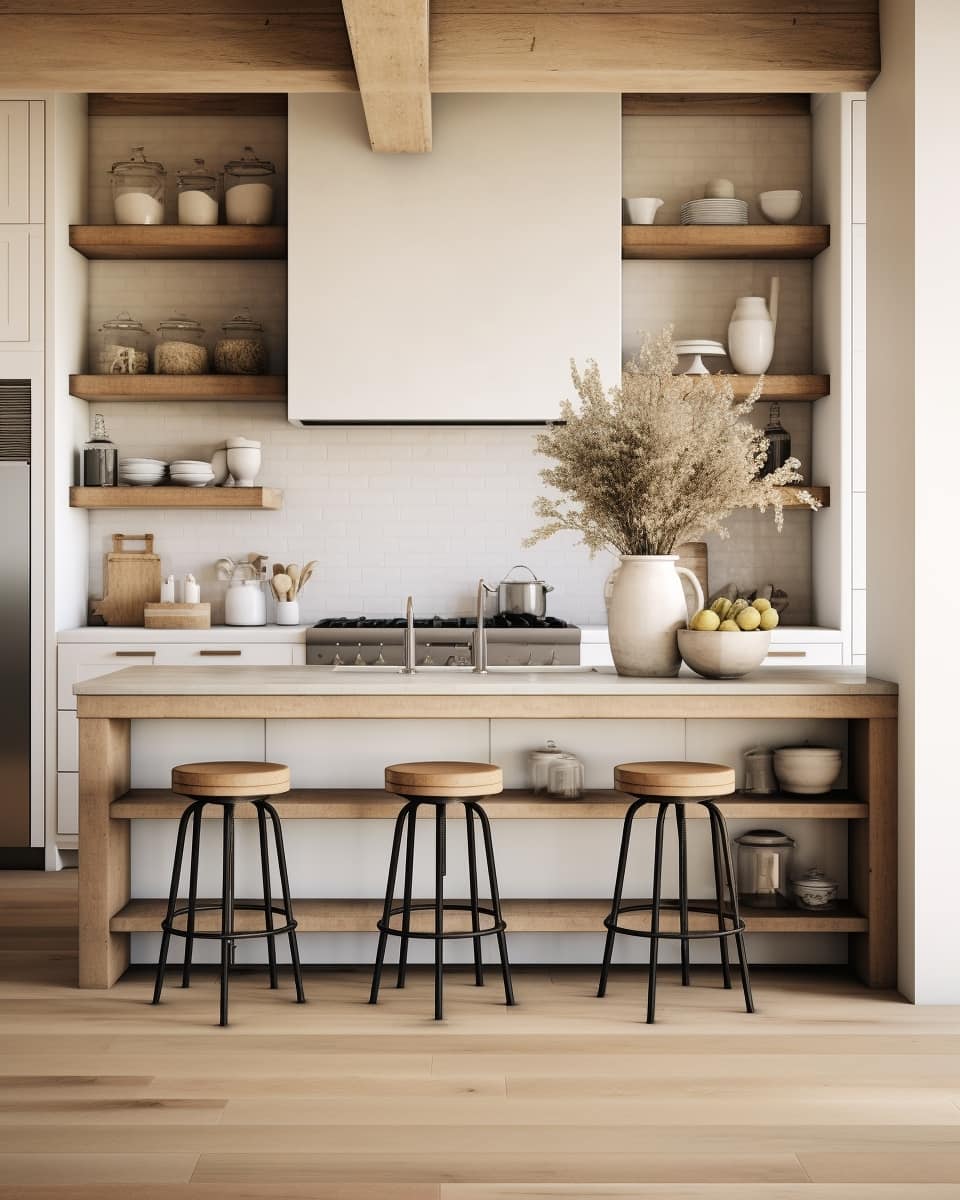
Frequently Asked Questions
How Often Should I Replace My Air Filters?
We replace our air filters regularly to maintain optimal HVAC performance. The frequency of air filter replacement depends on various factors such as the type of filter and the air quality in our environment.
Regular air filter maintenance is crucial to ensure clean air circulation, prevent dust buildup, and maintain proper airflow. By following a recommended air filter replacement schedule, we can improve indoor air quality and prolong the lifespan of our HVAC system.
What Are the Signs of a Ductwork Leak?
When it comes to ductwork repair and troubleshooting HVAC systems, it’s important to recognize the signs of a ductwork leak. These leaks can lead to uneven heating and cooling throughout your home. Look out for increased energy bills, weak airflow, and inconsistent temperature control.
If you suspect a leak, it’s crucial to address it promptly to avoid further damage and inefficiency. Professional inspection and sealing of the ductwork are recommended steps to resolve this issue.
Can I Balance Air Registers Myself or Do I Need to Hire a Professional?
When it comes to DIY air register balancing, it’s important to consider the complexity and potential risks involved.
While some homeowners may feel confident in tackling this task themselves, it’s generally recommended to hire a professional HVAC technician.
A professional will have the knowledge, experience, and specialized tools to properly assess and adjust the airflow in your HVAC system.
This ensures a more accurate and effective solution to resolve uneven heating and cooling in your home.
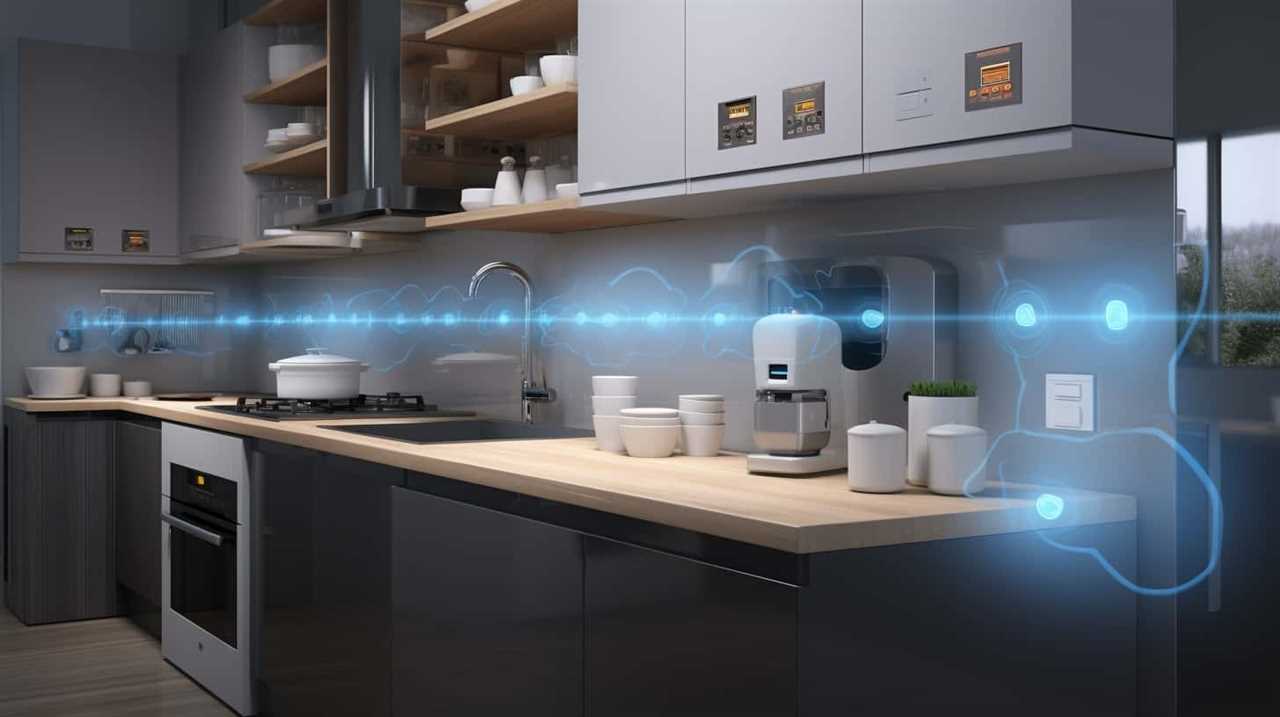
How Can I Clean and Maintain My Outdoor Unit?
When it comes to cleaning and maintaining our outdoor unit, there are a few key cleaning techniques and troubleshooting tips we can follow.
Firstly, make sure to turn off the power to the unit before starting any cleaning.
Remove any debris or leaves from the unit using a brush or vacuum.
Next, gently hose down the unit to remove any dirt or grime.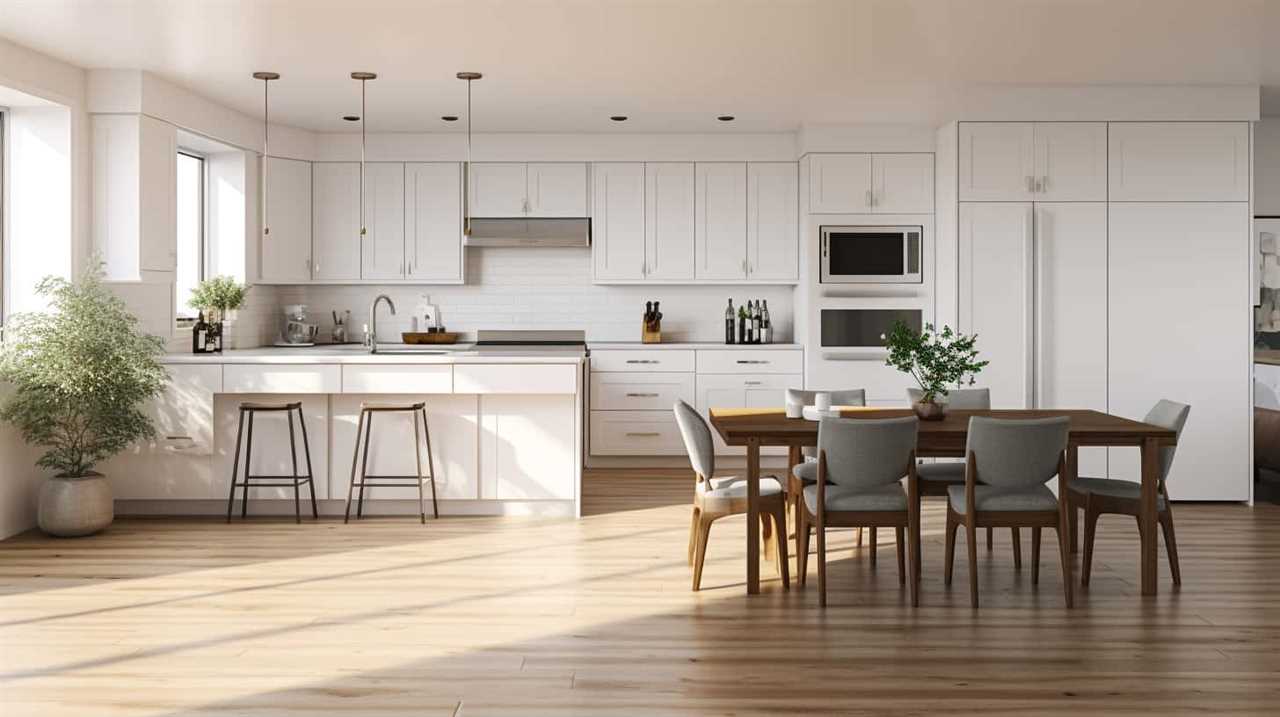
Finally, check for any damaged or loose parts and make any necessary repairs.
Regular maintenance like this can help keep our outdoor unit running smoothly.
What Are the Benefits of Installing a Zoning System in My HVAC System?
Installing a zoning system in your HVAC system can have numerous benefits.
It allows for more precise control over the temperature in different areas of your home, ensuring comfort for everyone.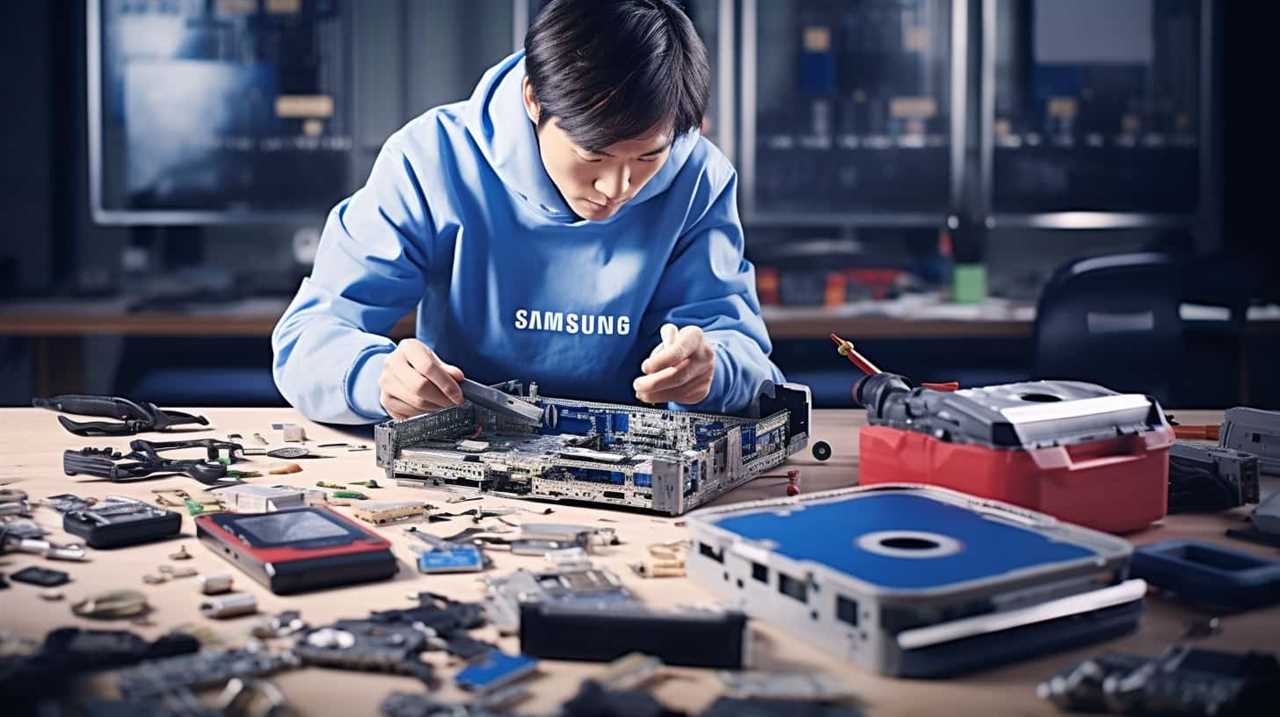
Additionally, it can help improve indoor air quality by minimizing the spread of allergens and pollutants.
By only heating or cooling the rooms that are being used, you can also save energy and reduce your utility bills.
What Are the Best Steps to Take to Resolve Uneven HVAC Heating & Cooling?
When dealing with uneven heating in your HVAC system, it’s important to follow expert tips for uneven heating to effectively resolve the issue. Start by checking for blocked vents, insulating ductwork, and ensuring proper maintenance of your HVAC system. Consulting a professional for a thorough inspection may also be necessary.
Conclusion
In conclusion, resolving uneven HVAC heating and cooling can be achieved by following these 9 simple steps.
- Check air filters.
- Inspect ductwork for leaks.
- Balance air registers.
- Clean and maintain the outdoor unit.
- Ensure proper insulation.
- Adjust thermostat settings.
- Consider zoning system installation.
- Schedule regular HVAC maintenance.
- Consult a professional for further assistance.
By following these steps, you can ensure a comfortable and efficient climate control system.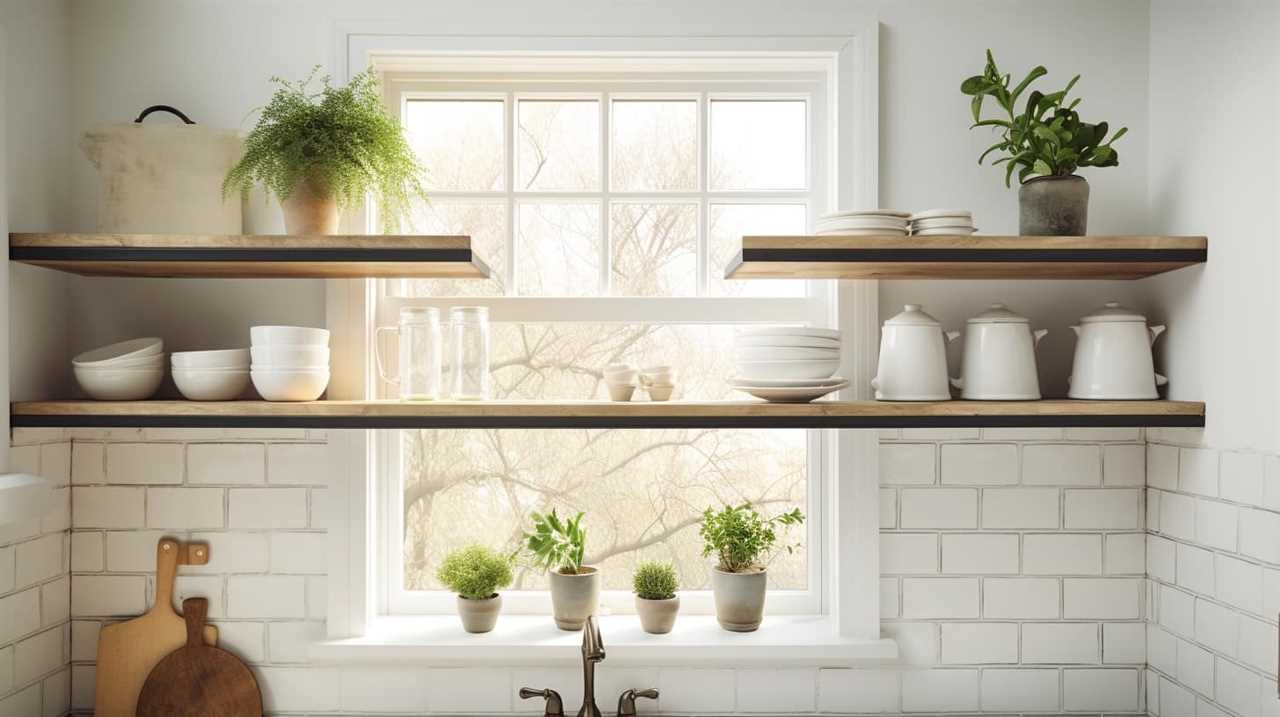
Don’t let your HVAC system play hot and cold with you, take control and enjoy the perfect temperature throughout your space.
- About the Author
- Latest Posts
Introducing Charles, the Editor in Chief at ByRetreat, whose passion for interior design and editorial excellence elevates every remote workspace to new heights. With his keen eye for detail, impeccable taste, and expertise in design, Charles brings a wealth of knowledge and creativity to the ByRetreat team.
As the Editor in Chief of a renowned lifestyle blog, Charles has honed his skills in curating captivating content and staying up-to-date with the latest trends in interior design. His deep understanding of aesthetics and the power of storytelling through design enables him to create remote workspaces that are not only visually stunning but also rich in personality and meaning.
Garage Door Opener
Replacing Raynor Garage Door Opener Parts: A How-To Guide
A comprehensive guide to replacing Raynor garage door opener parts, essential for troubleshooting and maintaining your garage door – find out how!

When it comes to keeping our garage door openers in top condition, sometimes parts need a little update. In our newest guide, we explain step-by-step how to replace Raynor garage door opener components with accuracy and simplicity.
From deciphering which parts may be causing issues to mastering the art of installation, this how-to guide is a must-have for anyone seeking to keep their garage in top shape.
Stay tuned for expert tips on troubleshooting, identifying faulty parts, and ensuring your garage door opener is running smoothly for the long haul.
Key Takeaways
- Ensure safety by disconnecting power before replacing parts.
- Use proper tools and refer to the manual for efficient replacement.
- Test the new components thoroughly for smooth operation.
- Maintain long-term opener health with regular maintenance and inspections.
Troubleshooting Common Raynor Opener Problems
When troubleshooting common Raynor opener problems, it's crucial to systematically address each potential issue to pinpoint the root cause efficiently.
Starting with the garage door opener, ensure that power sources are intact and functioning correctly. Check for any loose connections or tripped circuit breakers that may be impeding the opener's operation.
Next, inspect the remote control and replace the batteries if necessary to rule out any issues with the signal transmission. Align the safety sensors in the garage to guarantee they're facing each other and unobstructed, as misalignment can prevent the door from closing properly.
If the opener exhibits erratic movements or produces loud noises, consider adjusting the settings or lubricating the components to improve its performance. Refer to the opener's manual to understand any error codes displayed, aiding in the identification of specific problems.
Identifying Faulty Garage Door Opener Parts

To accurately identify faulty garage door opener parts, we must thoroughly inspect each component for signs of wear, malfunction, or damage that could be contributing to operational issues. When troubleshooting issues with a garage door opener, common problematic parts include the motor, circuit board, gears, sensors, belts, chains, and remote control. Noisy operation, slow opening or closing, or complete failure are indicators of potential faults within these components. Regular maintenance and inspection are crucial to prevent sudden failures and extend the lifespan of the garage door opener.
To pinpoint the specific faulty part, a systematic approach is necessary. Start by visually examining each part for any visible signs of wear or damage. Next, test the functionality of the opener to identify which component is causing the problem. Consulting the owner's manual or seeking professional assistance can provide valuable insights into diagnosing and replacing the faulty garage door opener parts accurately. By identifying and addressing these issues promptly, you can ensure smooth and efficient operation of your garage door opener.
Steps for Replacing Raynor Opener Components
For efficient replacement of Raynor opener components, meticulously identify the specific faulty part necessitating attention. Once you have pinpointed the problematic component, follow these steps to seamlessly replace it:
- Refer to the Raynor garage door opener manual: This document provides essential guidance on the disassembly and replacement procedures specific to your model.
- Ensure safety measures: Prioritize safety by disconnecting power to the opener before commencing any repair work to prevent accidents.
- Utilize the right tools: Employ tools like screwdrivers and pliers to carefully remove and replace the faulty opener part, ensuring a precise and secure fit.
- Thoroughly test the new component: Before reassembling the opener, verify the proper functioning of the replaced part through comprehensive testing to guarantee optimal performance.
Following these steps will facilitate a successful garage door repair, allowing you to restore your Raynor opener to full functionality efficiently.
Testing the Replaced Parts for Functionality

Testing the functionality of replaced Raynor garage door opener parts involves operating the door multiple times to ensure smooth and proper functioning. After replacing the parts, it's crucial to check for any unusual noises, jerky movements, or malfunctioning features that may indicate underlying issues.
Observing how the door responds to remote commands is essential to ensure that the opener parts are working accurately and promptly. Additionally, verifying the correct operation of safety features, such as auto-reverse mechanisms, is paramount for the safe use of garage doors.
A thorough final inspection should be conducted to confirm that the replaced parts have effectively addressed the previous problems and that the garage door opener is now operating smoothly and safely. By meticulously testing the functionality of the replaced parts, you can ensure the optimal performance of your Raynor garage door opener and maintain a secure and efficient operation of your garage doors.
Maintenance Tips for Long-Term Opener Health
After ensuring the functionality of replaced Raynor garage door opener parts, maintaining long-term opener health is crucial for optimal performance and safety. Here are some essential maintenance tips to keep your Raynor Garage door opener in top condition:
- Regular Lubrication: Keep chains, screws, and hinges well-lubricated to minimize friction and wear, ensuring smooth operation.
- Hardware Inspection: Periodically inspect and tighten all hardware on the opener to prevent loose parts that could lead to malfunctions.
- Clean Photo-eye Sensors: Ensure the photo-eye sensors are clean to prevent any obstructions that could affect the opener's safety features.
- Check Door Balance: Regularly check and adjust the balance of the garage door to reduce strain on the opener, extending its lifespan.
Frequently Asked Questions
Where Is the Model Number on a Raynor Garage Door Opener?
We can find the model number of a Raynor garage door opener on the motor housing or remote control. Look for a sticker or label on the opener unit itself. Having this number is crucial for ordering the correct replacement parts.
If the model number isn't on the opener, check the owner's manual or contact Raynor customer support. This information guarantees you get the right parts when fixing or replacing components of your Raynor garage door opener.
How Do I Know What Model Garage Door I Have?
To determine the model of your garage door, look for a label or tag with the manufacturer's information. Check the owner's manual or search online for images of Raynor garage doors.
Contact customer service for help using the serial number. Measure the door's dimensions against standard sizes for Raynor models. These methods will help identify the specific model of your garage door.
Are Raynor and Liftmaster Garage Door Openers the Same?
Like comparing apples to oranges, Raynor and Liftmaster garage door openers aren't the same. While both brands offer quality products, they've distinct differences in features, warranties, and compatibility with various garage door systems.
It's essential to research and select the brand that best fits your specific needs and preferences to ensure optimal performance and satisfaction with your garage door opener.
What Parts Come With a New Garage Door Opener?
When you purchase a new garage door opener, it typically includes the motor unit, remote controls, safety sensors, wall control panel, rail assembly, and mounting hardware.
The motor unit functions as the core component responsible for lifting and lowering the door, while the remote controls allow you to operate the opener from a distance.
Safety sensors detect obstructions for safe operation, and the wall control panel provides convenient access from inside the garage.
Conclusion
After following our step-by-step guide to replacing Raynor garage door opener parts, you'll be amazed at how simple and cost-effective DIY repairs can be.
By identifying faulty components, performing the replacement process, and testing for functionality, you'll have your garage door opener running smoothly in no time.
Remember to regularly maintain your opener for long-term health and enjoy the satisfaction of a job well done.
Happy repairing!
- About the Author
- Latest Posts
Introducing Ron, the home decor aficionado at ByRetreat, whose passion for creating beautiful and inviting spaces is at the heart of his work. With his deep knowledge of home decor and his innate sense of style, Ron brings a wealth of expertise and a keen eye for detail to the ByRetreat team.
Ron’s love for home decor goes beyond aesthetics; he understands that our surroundings play a significant role in our overall well-being and productivity. With this in mind, Ron is dedicated to transforming remote workspaces into havens of comfort, functionality, and beauty.
-

 Vetted2 weeks ago
Vetted2 weeks ago15 Best Drip Irrigation Systems to Keep Your Garden Thriving
-
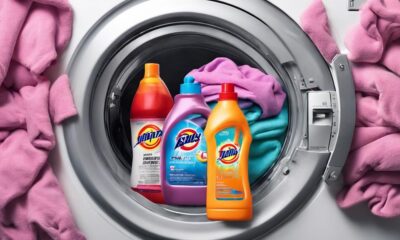
 Vetted2 days ago
Vetted2 days ago15 Best Sports Laundry Detergents for Keeping Your Activewear Fresh and Clean
-
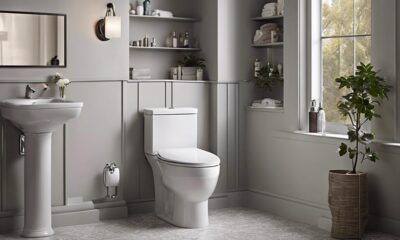
 Vetted4 days ago
Vetted4 days ago15 Best Tall Toilets for Seniors That Combine Comfort and Safety
-

 Vetted1 week ago
Vetted1 week ago15 Best Dish Scrubbers to Keep Your Kitchen Sparkling Clean
-

 Beginners Guides3 weeks ago
Beginners Guides3 weeks agoDesigning Your Retreat Center – Essential Tips
-
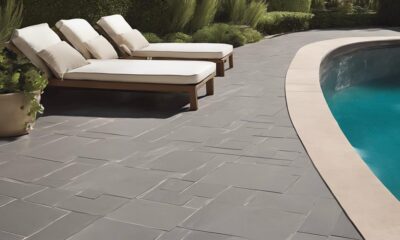
 Vetted3 weeks ago
Vetted3 weeks ago15 Best Tile Adhesives for Outdoor Use – Top Picks for Durable and Weather-Resistant Installations
-

 Beginners Guides3 weeks ago
Beginners Guides3 weeks agoAre Retreats Profitable
-

 Decor1 week ago
Decor1 week agoWhat Is Eclectic Home Decor







